

The 10-Step Guide for a Successful Strategy Presentation
Discover essential steps and best practices in 'How to Write a Strategy Presentation.' Elevate your approach and effectively communicate your strategic vision with our comprehensive guide.

StrategyPunk
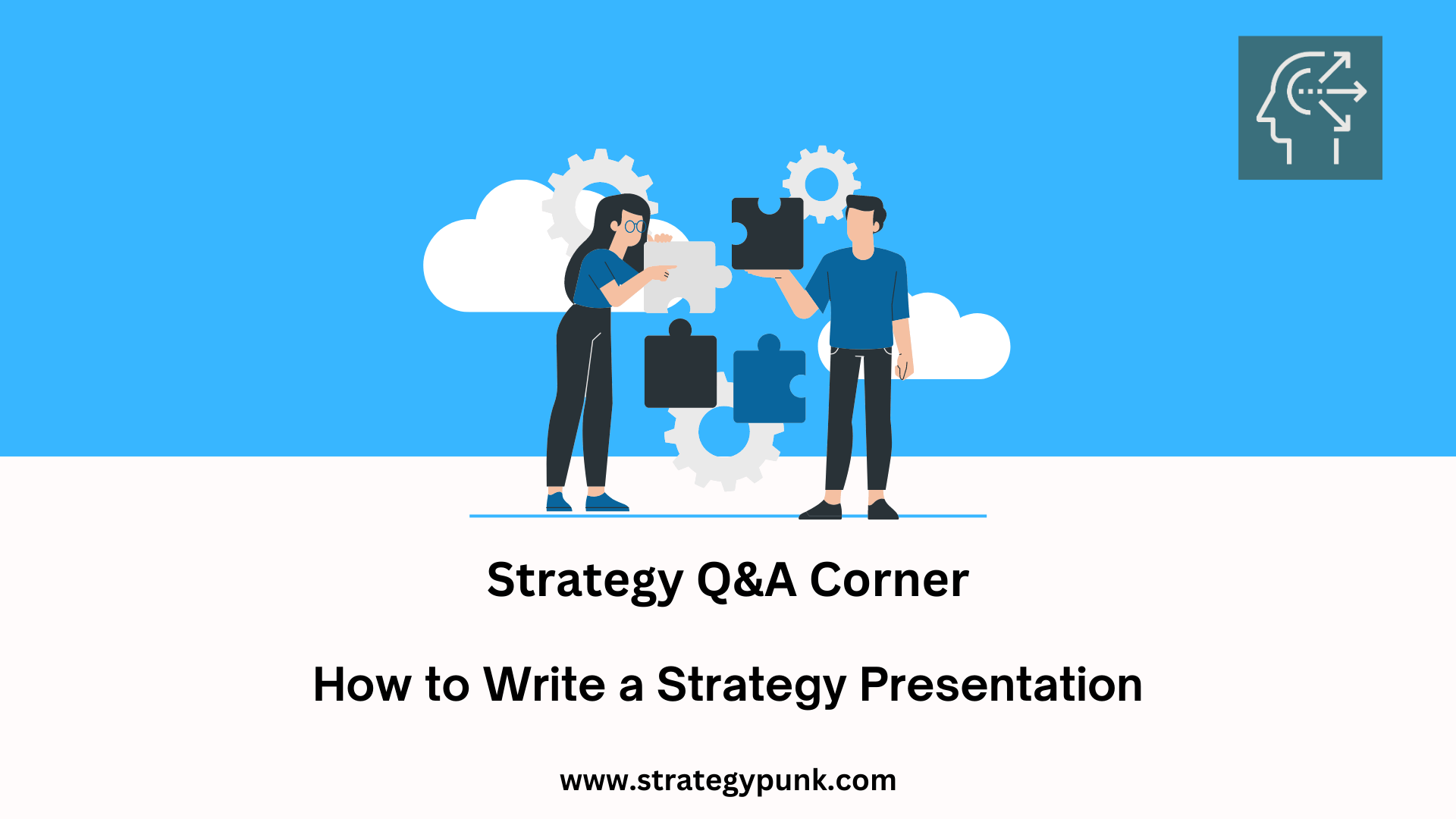
Introduction
Have you ever been trapped in the quicksand of a never-ending strategy presentation?
We've all been there, nodding off while someone drones on.
Now, picture this: a room hanging onto your every word, eyes lit with interest.
Impossible?
Think again. Plunge into our fresh guide, and you'll transform from a presenter to a storyteller.
It’s time for your audience to listen and be utterly captivated.
How to Write a Strategy Presentation: 10 Steps
1. set the stage right.
You wouldn’t host a grand ball without knowing who’s attending, right?
In the same way, before you even think of diving into your content, please know your audience.
Are they tech wizards or old-school board members? Millennials or Baby Boomers?
Customize your talk to resonate with them. Understand their needs, their pain points, and their aspirations.
Connect on a personal level, and half your battle is already won. 🎯
2. Define Your Mission
Imagine embarking on a road trip without a map.
A strategy presentation without a clear mission is almost the same – directionless and meandering.
So, ask yourself: Why are you here? What's the core message?
Once you have that clarity, your path becomes straightforward. Trust me, your audience will thank you for it.
3. Craft an Unforgettable Opening
First impressions?
They’re everything. You have 60 seconds to grab your audience's attention, so make those seconds count.
A quirky quote, a compelling statistic, or even a personal anecdote – choose a relevant and riveting opener. It’s the appetizer to your main course.
Make sure it's tantalizing!
4. Break Down the Core
a. Highlight the Issue:
Every story needs a conflict.
In your strategy presentation, this is the issue or challenge at hand.
Paint a vivid picture. Make them see what’s going awry.
But remember, no doom and gloom—just honest, relatable content.
b. Showcase Your Solution:
Now, for the hero of our story – your solution. Get straight to the point.
How will your idea transform the current scenario?
Make your key the shining beacon. Sell not just the picture but the dream.
c. Unveil the Game Plan:
So, you’ve hooked them with the problem and dazzled them with your solution.
The roadmap: Walk them through the how. Detail the journey, step by step, action by action. Make it tangible. Make it achievable.
5. Elevate with Design
Yes, content is king. But design?
It’s the crown. Incorporate visuals that speak. Charts, infographics, images – let them do the heavy lifting. Remember, a picture's worth a thousand words, but a relevant picture?
That’s gold. And hey, always lean into simplicity. Less is more, especially on slides. 🖼️
6. Weave in Stories
Facts need to be remembered. Stories? They stick.
Weave in anecdotes that resonate. Personal tales, success stories, or even fictional scenarios – a narrative touch can bring your presentation alive. Make it relatable.
Could you make it memorable? After all, who doesn't love a good story?
7. Get Them Talking
No one enjoys a monologue. You can turn your presentation into a dialogue.
Ask questions. Seek opinions. Maybe even throw in a mini poll or quiz. Engage them.
The more involved they are, the more invested they become. It's the difference between passive listeners and active participants.
8. Wrap it Up with Pizzazz
You're nearing the end. This is where you cement all you've shared.
Highlight the key points and end with a zinger. It could be a call to action, a memorable quote, or a challenge.
Leave them thinking, reflecting, and wanting more.
9. Rehearse to Perfection
You've crafted this masterpiece. Now, could you give it the respect it deserves?
Know each slide, each transition, and each pause. Familiarize yourself with the flow. The more comfortable you are with the material, the more confidently you'll deliver.
And nothing, absolutely nothing, captivates an audience more than genuine confidence.
10. After the Applause: Your Next Moves
The applause fades—the room empties.
But your job? It still needs to be done. Show gratitude. A simple thank you can work wonders. Would you be willing to share your presentation or additional resources?
And always, always be open to feedback. It’s the breakfast of champions, after all.
Crafting a killer strategy presentation isn’t about big words or fancy jargon. It’s about connection, clarity, and confidence. You’ve got the palette, brush, and canvas.
Now, could you paint your masterpiece? 🎨
Remember, strategy presentations are not just about informing. It’s about transforming.
So, go ahead and inspire change—illuminate minds. And make a lasting impact.🚀
Sign up for StrategyPunk
Everything strategy & beyond. All the content, templates, and worksheets to develop and execute your strategy. Join 3000+ professionals.
No spam. Unsubscribe anytime.
Bonus: Your Strategy Presentation Success Checklist
Please ensure that your strategy presentation is top-notch with our concise Success Checklist.
This list will guide you through each crucial step for impactful delivery, from understanding your audience to gathering feedback post-presentation.
Your trusty companion for every presentation!
- Audience insights in place.
- Is the Mission crystal clear? ✔️
- Powerful start rehearsed.
- Core content organized.
- Engaging visuals ready.
- Personal story integrated.
- Interactive segment prepped.
- Strong conclusion framed.
- Feedback channels open.

Xpeng SWOT Analysis: Free PPT Template and In-Depth Insights (free file)
Unlock key insights into Xpeng with our free SWOT analysis PPT template. Dive deep into its business dynamics at no cost.

Strategic Insights 2024: A SWOT Analysis of Nestle (Plus Free PPT)
Explore Nestle's strategic outlook with our SWOT analysis for 2024. This PowerPoint template highlights key areas for growth and challenges.
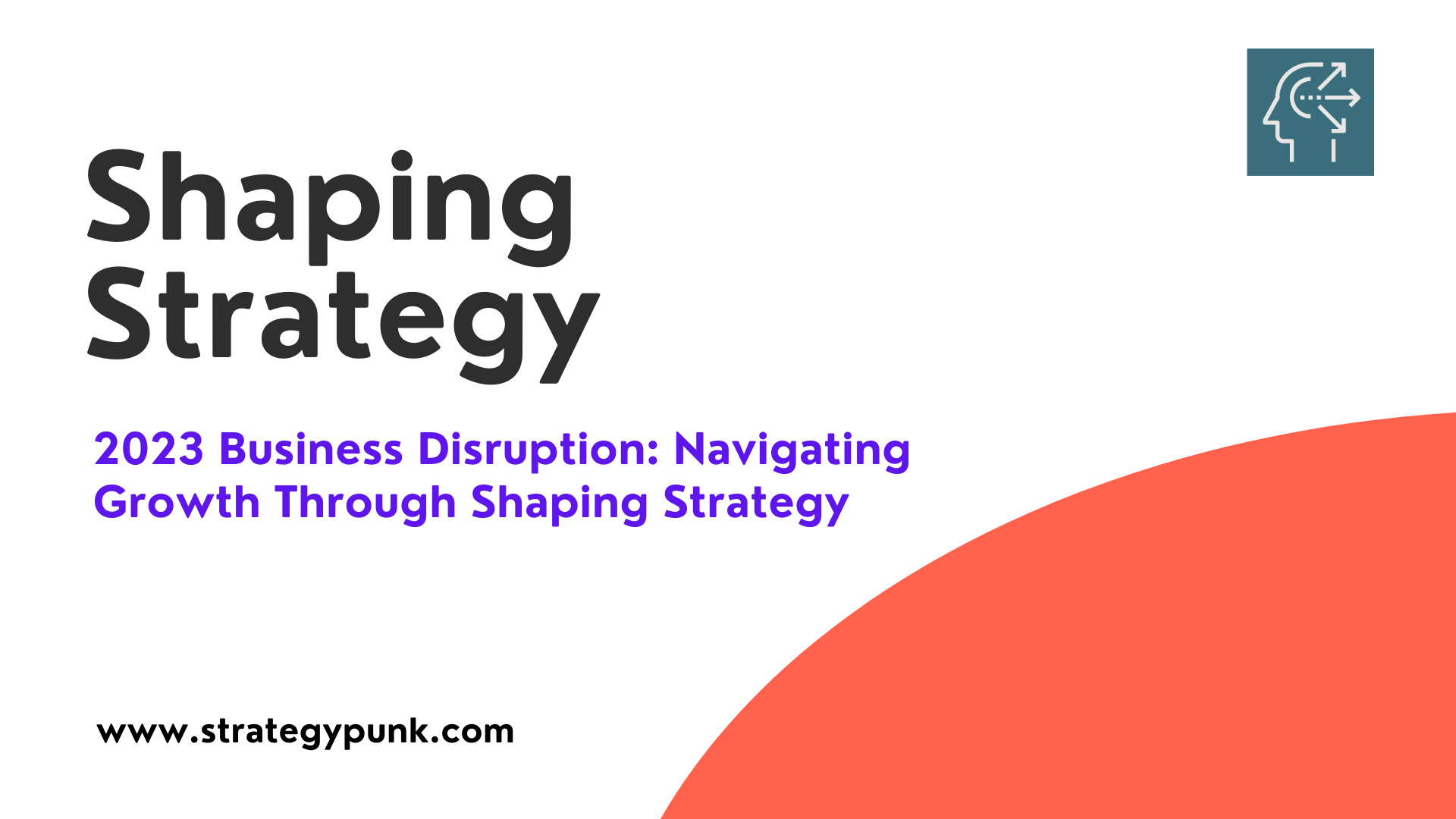
2024 Business Disruption: Navigating Growth Through Shaping Strategy
Discover the importance of being a shaper in 2023's business ecosystem. Shaping strategy, attracting a critical mass of participants, and finding the right strategic path to create value.
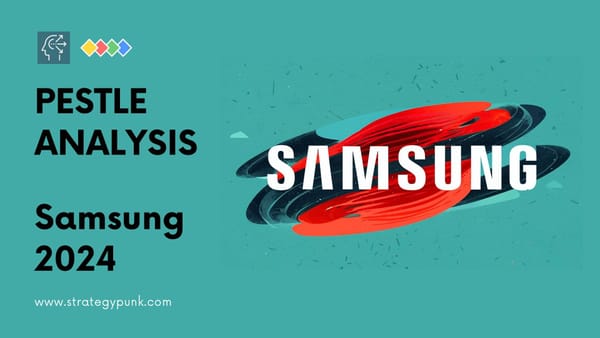
Samsung PESTLE Analysis: Unveiling the Driving Forces (Free PPT)
Download our comprehensive guide: Samsung PESTLE Analysis (Free PPT). Discover the strategic insights & driving forces shaping Samsung's future.

How it works
Transform your enterprise with the scalable mindsets, skills, & behavior change that drive performance.
Explore how BetterUp connects to your core business systems.
We pair AI with the latest in human-centered coaching to drive powerful, lasting learning and behavior change.
Build leaders that accelerate team performance and engagement.
Unlock performance potential at scale with AI-powered curated growth journeys.
Build resilience, well-being and agility to drive performance across your entire enterprise.
Transform your business, starting with your sales leaders.
Unlock business impact from the top with executive coaching.
Foster a culture of inclusion and belonging.
Accelerate the performance and potential of your agencies and employees.
See how innovative organizations use BetterUp to build a thriving workforce.
Discover how BetterUp measurably impacts key business outcomes for organizations like yours.
A demo is the first step to transforming your business. Meet with us to develop a plan for attaining your goals.

- What is coaching?
Learn how 1:1 coaching works, who its for, and if it's right for you.
Accelerate your personal and professional growth with the expert guidance of a BetterUp Coach.
Types of Coaching
Navigate career transitions, accelerate your professional growth, and achieve your career goals with expert coaching.
Enhance your communication skills for better personal and professional relationships, with tailored coaching that focuses on your needs.
Find balance, resilience, and well-being in all areas of your life with holistic coaching designed to empower you.
Discover your perfect match : Take our 5-minute assessment and let us pair you with one of our top Coaches tailored just for you.

Research, expert insights, and resources to develop courageous leaders within your organization.
Best practices, research, and tools to fuel individual and business growth.
View on-demand BetterUp events and learn about upcoming live discussions.
The latest insights and ideas for building a high-performing workplace.
- BetterUp Briefing
The online magazine that helps you understand tomorrow's workforce trends, today.
Innovative research featured in peer-reviewed journals, press, and more.
Founded in 2022 to deepen the understanding of the intersection of well-being, purpose, and performance
We're on a mission to help everyone live with clarity, purpose, and passion.
Join us and create impactful change.
Read the buzz about BetterUp.
Meet the leadership that's passionate about empowering your workforce.
For Business
For Individuals
How to give a good presentation that captivates any audience

Jump to section
What are the main difficulties when giving presentations?
How to create an effective presentation, after that, how do i give a memorable presentation, how to connect with the audience when presenting.
If you’ve ever heard someone give a powerful presentation, you probably remember how it made you feel. Much like a composer, a good speaker knows precisely when each note should strike to captivate their audience’s attention and leave them with a lasting impression.
No one becomes a great public speaker or presenter without practice. And almost everyone can recall a time one of their presentations went badly — that’s a painful part of the learning process.
Whether you’re working within a small creative team or a large organization, public speaking and presentation skills are vital to communicating your ideas. Knowing how to present your vision can help you pitch concepts to clients, present ideas to your team, and develop the confidence to participate in team meetings.
If you have an upcoming presentation on the horizon and feel nervous, that’s normal. Around 15-30% of the general population experience a fear of public speaking . And, unfortunately, social anxiety is on the rise, with a 12% increase in adults over the last 20 years .
Learning how to give a good presentation can dismantle your fears and break down these barriers, ensuring you’re ready to confidently share your point of view.
It’s the week before your presentation, and you’re already feeling nervous . Maybe there’ll be an important mentor in the room you need to impress, or you’re looking for an opportunity to show your boss your value. Regardless of your countless past presentations, you still feel nervous.
Sharing your vision and ideas with any sized group is intimidating. You’re likely worrying about how you’ll perform as a presenter and whether the audience will be interested in what you offer. But nerves aren’t inherently negative — you can actually use this feeling to fuel your preparation.

It’s helpful to identify where your worries are coming from and address your fears. Here are some common concerns when preparing for an upcoming presentation:
Fear of public speaking: When you share your ideas in front of a group, you’re placing yourself in a vulnerable position to be critiqued on your knowledge and communication skills . Maybe you feel confident in your content, but when you think about standing in front of an audience, you feel anxious and your mind goes blank.
It’s also not uncommon to have physical symptoms when presenting . Some people experience nausea and dizziness as the brain releases adrenaline to cope with the potentially stressful situation . Remember to take deep breaths to recenter yourself and be patient, even if you make a mistake.
Losing the audience’s attention: As a presenter, your main focus is to keep your audience engaged. They should feel like they’re learning valuable information or following a story that will improve them in life or business.
Highlight the most exciting pieces of knowledge and ensure you emphasize those points in your presentation. If you feel passionate about your content, it’s more likely that your audience will experience this excitement for themselves and become invested in what you have to say.
Not knowing what content to place on presentation slides: Overloading presentation slides is a fast way to lose your audience’s attention. Your slides should contain only the main talking points and limited text to ensure your audience focuses on what you have to say rather than becoming distracted by the content on your slides.
Discomfort incorporating nonverbal communication: It’s natural to feel stiff and frozen when you’re nervous. But maintaining effective body language helps your audience stay focused on you as you speak and encourages you to relax.
If you struggle to incorporate body language into your presentations, try starting small by making hand gestures toward your slides. If you’re working with a large audience, use different parts of the stage to ensure everyone feels included.
Each presenter has their own personal brand and style. Some may use humor to break the ice, while others might appeal to the audience’s emotional side through inspiring storytelling.
Watching online presentations, such as TED talks, is an excellent way to expose yourself to various presentation styles and develop your own. While observing others, you can note how they carry themselves on stage and learn new ways to keep your audience engaged.
Once you’ve addressed what’s causing your fears, it’s time to prepare for a great presentation. Use your past experience as inspiration and aim to outshine your former self by learning from your mistakes and employing new techniques. Here are five presentation tips to help you create a strong presentation and wow your audience:
1. Keep it simple
Simple means something different to everyone.
Before creating your presentation, take note of your intended audience and their knowledge level of your subject. You’ll want your content to be easy for your intended audience to follow.
Say you’re giving a presentation on improving your company’s operational structure. Entry-level workers will likely need a more straightforward overview of the content than C-suite leaders, who have significantly more experience.
Ask yourself what you want your audience to take away from your presentation and emphasize those important points. Doing this ensures they remember the most vital information rather than less important supporting ideas. Try organizing these concepts into bullet points so viewers can quickly identify critical takeaways.
2. Create a compelling structure
Put yourself in your audience member’s shoes and determine the most compelling way to organize your information. Your presentation should be articulate , cohesive, and logical, and you must be sure to include all necessary supporting evidence to strengthen your main points.
If you give away all of your answers too quickly, your audience could lose interest. And if there isn’t enough supporting information, they could hit a roadblock of confusion. Try developing a compelling story that leads your audience through your thought processes so they can experience the ups and downs alongside you.
By structuring your presentation to lead up to a final conclusion, you’re more likely to keep listeners’ attention. Once you’ve reached that conclusion, you can offer a Q&A period to put any of their questions or concerns to rest.
3. Use visual aids
Appealing to various learning styles is a great way to keep everyone on the same page and ensure they absorb your content. Visual aids are necessary for visual learners and make it easier for people to picture your ideas.
Aim to incorporate a mixture of photos, videos, and props to engage your audience and convey your key points. For instance, if you’re giving a presentation on anthropology subject matter, you could show your audience an artifact to help them understand how exciting a discovery must have been.
If your presentation is long, including a video for your audience to watch is an excellent way to give yourself a break and create new jumping-off points for your speech.
4. Be aware of design techniques and trends
Thanks to cutting-edge technology and tools, you have numerous platforms at your disposal to create a good presentation. But keep in mind that although color, images, and graphics liven things up, they can cause distraction when misused.
Here are a few standard pointers for incorporating visuals on your slides:
- Don’t place blocks of small text on a single slide
- Use a minimalistic background instead of a busy one
- Ensure text stands out against the background color
- Only use high-resolution photos
- Maintain a consistent font style and size throughout the presentation
- Don’t overuse transitions and effects
5. Try the 10-20-30 rule
Guy Kawasaki, a prominent venture capitalist and one of the original marketing specialists for Apple, said that the best slideshow presentations are less than 10 slides , last at most 20 minutes, and use a font size of 30. Following this strategy can help you condense your information, eliminate unnecessary ideas, and maintain your audience’s focus more efficiently.
Once you’re confident in creating a memorable presentation, it’s time to learn how to give one. Here are some valuable tips for keeping your audience invested during your talk:
Tip #1: Tell stories
Sharing an anecdote from your life can improve your credibility and increase your relatability. And when an audience relates to you, they’re more likely to feel connected to who you are as a person and encouraged to give you their full attention, as they would want others to do the same.
Gill Hicks utilized this strategy well when she shared her powerful story, “ I survived a terrorist attack. Here’s what I learned .” In her harrowing tale, Hicks highlights the importance of compassion, unconditional love, and helping those in need.
If you feel uncomfortable sharing personal stories, that’s okay. You can use examples from famous individuals or create a fictional account to demonstrate your ideas.
Tip #2: Make eye contact with the audience
Maintaining eye contact is less intimidating than it sounds. In fact, you don’t have to look your audience members directly in their eyes — you can focus on their foreheads or noses if that’s easier.
Try making eye contact with as many people as possible for 3–5 seconds each. This timing ensures you don’t look away too quickly, making the audience member feel unimportant, or linger too long, making them feel uncomfortable.
If you’re presenting to a large group, direct your focus to each part of the room to ensure no section of the audience feels ignored.

Tip #3: Work on your stage presence
Although your tone and words are the most impactful part of your presentation, recall that body language keeps your audience engaged. Use these tips to master a professional stage presence:
- Speak with open arms and avoid crossing them
- Keep a reasonable pace and try not to stand still
- Use hand gestures to highlight important information
Tip #4: Start strong
Like watching a movie trailer, the first seconds of your talk are critical for capturing your audience’s attention. How you start your speech sets the tone for the rest of your presentation and tells your audience whether or not they should pay attention. Here are some ways to start your presentation to leave a lasting impression:
- Use a quote from a well-known and likable influential person
- Ask a rhetorical question to create intrigue
- Start with an anecdote to add context to your talk
- Spark your audience’s curiosity by involving them in an interactive problem-solving puzzle or riddle
Tip #5: Show your passion
Don’t be afraid of being too enthusiastic. Everyone appreciates a speaker who’s genuinely excited about their field of expertise.
In “ Grit: The Power of Passion and Perseverance ,” Angela Lee Duckworth discusses the importance of passion in research and delivery. She delivers her presentation excitedly to show the audience how excitement piques interest.
Tip #6: Plan your delivery
How you decide to deliver your speech will shape your presentation. Will you be preparing a PowerPoint presentation and using a teleprompter? Or are you working within the constraints of the digital world and presenting over Zoom?
The best presentations are conducted by speakers who know their stuff and memorize their content. However, if you find this challenging, try creating notes to use as a safety net in case you lose track.
If you’re presenting online, you can keep notes beside your computer for each slide, highlighting your key points. This ensures you include all the necessary information and follow a logical order.

Tip #7: Practice
Practice doesn’t make perfect — it makes progress. There’s no way of preparing for unforeseen circumstances, but thorough practice means you’ve done everything you can to succeed.
Rehearse your speech in front of a mirror or to a trusted friend or family member. Take any feedback and use it as an opportunity to fine-tune your speech. But remember: who you practice your presentation in front of may differ from your intended audience. Consider their opinions through the lens of them occupying this different position.
Tip #8: Read the room
Whether you’re a keynote speaker at an event or presenting to a small group of clients, knowing how to read the room is vital for keeping your audience happy. Stay flexible and be willing to move on from topics quickly if your listeners are uninterested or displeased with a particular part of your speech.
Tip #9: Breathe
Try taking deep breaths before your presentation to calm your nerves. If you feel rushed, you’re more likely to feel nervous and stumble on your words.
The most important thing to consider when presenting is your audience’s feelings. When you approach your next presentation calmly, you’ll put your audience at ease and encourage them to feel comfortable in your presence.
Tip #10: Provide a call-to-action
When you end your presentation, your audience should feel compelled to take a specific action, whether that’s changing their habits or contacting you for your services.
If you’re presenting to clients, create a handout with key points and contact information so they can get in touch. You should provide your LinkedIn information, email address, and phone number so they have a variety of ways to reach you.
There’s no one-size-fits-all template for an effective presentation, as your unique audience and subject matter play a role in shaping your speech. As a general rule, though, you should aim to connect with your audience through passion and excitement. Use strong eye contact and body language. Capture their interest through storytelling and their trust through relatability.
Learning how to give a good presentation can feel overwhelming — but remember, practice makes progress. Rehearse your presentation for someone you trust, collect their feedback , and revise. Practicing your presentation skills is helpful for any job, and every challenge is a chance to grow.
Elevate your communication skills
Unlock the power of clear and persuasive communication. Our coaches can guide you to build strong relationships and succeed in both personal and professional life.
Elizabeth Perry, ACC
Elizabeth Perry is a Coach Community Manager at BetterUp. She uses strategic engagement strategies to cultivate a learning community across a global network of Coaches through in-person and virtual experiences, technology-enabled platforms, and strategic coaching industry partnerships. With over 3 years of coaching experience and a certification in transformative leadership and life coaching from Sofia University, Elizabeth leverages transpersonal psychology expertise to help coaches and clients gain awareness of their behavioral and thought patterns, discover their purpose and passions, and elevate their potential. She is a lifelong student of psychology, personal growth, and human potential as well as an ICF-certified ACC transpersonal life and leadership Coach.
6 presentation skills and how to improve them
How to make a presentation interactive and exciting, how to write a speech that your audience remembers, 3 stand-out professional bio examples to inspire your own, tell a story they can't ignore these 10 tips will teach you how, reading the room gives you an edge — no matter who you're talking to, writing an elevator pitch about yourself: a how-to plus tips, 18 effective strategies to improve your communication skills, your ultimate guide on how to be a good storyteller, similar articles, the importance of good speech: 5 tips to be more articulate, the 11 tips that will improve your public speaking skills, 30 presentation feedback examples, how to not be nervous for a presentation — 13 tips that work (really), how the minto pyramid principle can enhance your communication skills, 8 clever hooks for presentations (with tips), stay connected with betterup, get our newsletter, event invites, plus product insights and research..
3100 E 5th Street, Suite 350 Austin, TX 78702
- Platform Overview
- Integrations
- Powered by AI
- BetterUp Lead
- BetterUp Manage™
- BetterUp Care™
- Sales Performance
- Diversity & Inclusion
- Case Studies
- Why BetterUp?
- About Coaching
- Find your Coach
- Career Coaching
- Communication Coaching
- Life Coaching
- News and Press
- Leadership Team
- Become a BetterUp Coach
- BetterUp Labs
- Center for Purpose & Performance
- Leadership Training
- Business Coaching
- Contact Support
- Contact Sales
- Privacy Policy
- Acceptable Use Policy
- Trust & Security
- Cookie Preferences
Building Strategy Consulting Slide Decks: The Complete Guide
Table of contents.
There’s something different about slide decks from strategy consulting firms like McKinsey, Bain or BCG . For some reason, they just seem more convincing. But it’s difficult to pinpoint exactly what makes those presentations good.
As a strategy consultant, you very quickly realize there are two important components of a compelling strategy presentation:
- The ‘thinking’. This is the rigorous problem definition, analysis, synthesis, and insight that happens before you open up PowerPoint. Without this, even the most well-crafted strategy presentation lacks impact.
- The presentation. This is the distinctive, structured, and clear way that strategy consultants build their slide decks. Without this, even the most powerful insights lose their force.
In this guide, we show you how to do both those things. In chapters 1-3, we discuss how to structure your slide deck, define your objective, and craft a compelling argument and storyline.
Then in chapters 4-6, we show you best practices for building your slides and reviewing your slide deck.
By the end of this guide, you’ll have the ability to craft a compelling strategy slide deck with a clear and compelling storyline that leads your audience to your desired conclusion.
Structure your slide deck
Before we get into the detail of building your slide deck, it’s important to understand how to structure your presentation.
There is a common structure that is used for almost all strategy presentations. It’s based on a concept known as the Pyramid Principle , which was popularized by Barbara Minto at McKinsey & Co.
According to Minto, there are three components to a well-constructed slide deck:
- The executive summary: Provides the reader a full summary of the argument and recommendations within your slide deck for readers that are more interested in the ‘so what’ than the detailed analysis.
- The body slides: Illustrates the analysis that supports each claim you make in your slide deck’s argument and thus slide objective.
- Next steps or recommendations slides: Clearly outlines the key implications or ‘so what’ of your slide deck, as well as any next steps required.
In this guide, we will walk you through how to tackle each of these sections one by one. But first, we start by setting the objective of your slide deck, and crafting your argument and storyline.
Define the objective of your deck
Let’s start at the beginning. The purpose of your slide deck isn’t to show off all the things you know… or how great you are at analysis… or how beautiful your slides are.
Instead, the purpose of your slide deck is to persuade your audience and lead them to an objective. And, as the author of the slide deck, you need to set the objective before you start building your slide deck.
Having a clear objective for your slide deck is important for a number of reasons:
- It helps you focus your research and analysis on things that are relevant to your objective.
- You can quickly test the quality of your content by testing whether it is sufficient to achieve your objective.
- It helps inform the tone and positioning of the messages in your slides.
Your objective can take many forms. For example, it could be simply to inform your audience, to gain endorsement for a decision, or to achieve a specific action or next step.
As the author of the slide deck, you must ensure that the objective is clear and agreed upon. All the work that you’re about to do to build your slide deck is guided by your objective.
Craft the argument and storyline
Now that you’ve determined the objective of your slide deck, you need to craft an argument and storyline that leads to your objective.
To some extent, your slide deck’s argument will naturally appear from insights gathered through research and analysis. As you conduct research, you’ll slowly uncover the “real state of affairs”, which will be supported by data.
It’s your job to translate this argument into a compelling story; one that grabs the attention of your reader and communicates your argument in a clear and easy-to-understand way.
To do this, you should use a situation-complication-resolution storyline .
This is a universal structure; it’s used in books, plays, films, advertising, religion, politics, and more. It looks something like this:
- The scene is set and the characters are introduced (situation)
- Something goes wrong (complication)
- They fix the problem and live happily ever after (resolution)
When storytelling in PowerPoint, you should use the same structure. But in the context of your slide deck, your storyline will look something like:
- This thing is important (situation)
- There is a problem with this thing (complication)
- Therefore, we need to respond — and here is how (resolution)
The dot-dash structure
Writing a storyline for your presentation doesn’t happen in PowerPoint. In fact, you don’t open up PowerPoint until you’re completely satisfied with your storyline.
Instead of jumping into PowerPoint, you start by writing out your storyline in a text document using the dot-dash structure .
By writing your slide deck’s storyline in a text document, you can easily identify any faulty or missing logic in your story and ensure that you have the data required to support each claim you make.
And when you’re completely satisfied with your storyline, you can move it into PowerPoint. Your storyline should be communicated in the slide lead-ins, like so:
And once you’ve built the skeleton of your slide deck with the storyline communicated “horizontally” across the leads-ins, you’re ready to start building individual slides and the “vertical flow”.
Build body slides
Before you jump into building individual slides, there are two main components of slides that you need to understand:
- The lead-in: The text at the top of your slide. This should be written as an action title that communicates the implication or ‘so what’ of the slide, not describes the content of the slide.
- The slide body: The content of your slide. You should only communicate one insight per slide and choose the simplest method possible.
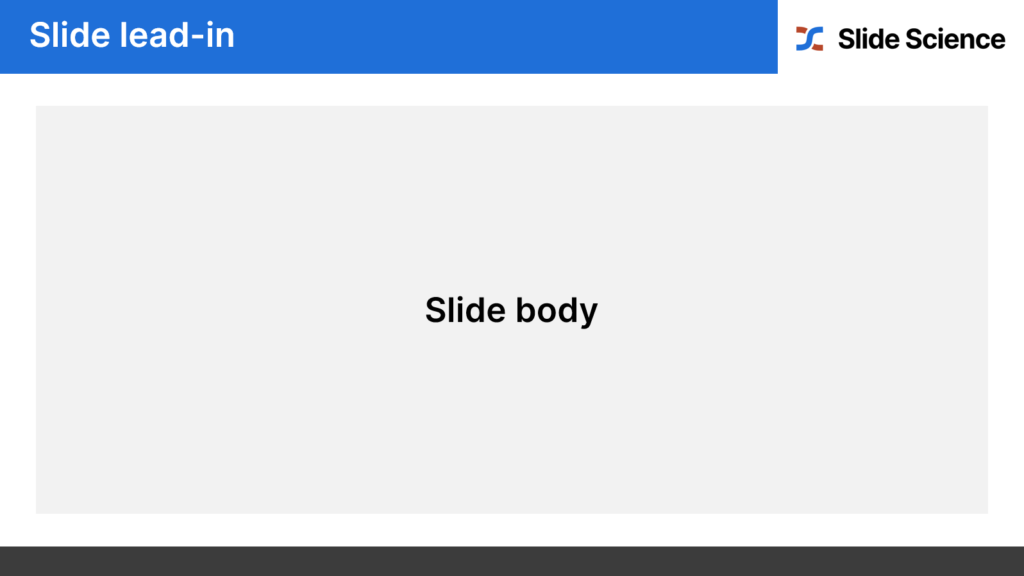
There is a close relationship between the slide lead-in and slide body. And this relationship is best explained by the Golden Rule of slide building.
The Golden Rule of slide building is:
“One slide, one insight, fully articulated in the lead-in, and supported by the body”
In other words, each slide should only communicate one insight. That insight should be fully explained in words in the lead-in, and fully supported by data in the slide body.
In addition, there should be nothing in the lead-in that’s not in the body, and nothing in the body that’s not in the lead-in.
Data, charts, and other quantitative slides
Claims that are supported by data are naturally more compelling than claims supported by ‘expert’ opinions, focus groups, and other qualitative evidence.
Therefore, where possible, you should always prioritize quantitative slides over qualitative slides.
But don’t go overboard with your data visualization. Sometimes it can be tempting to show off our technical skills by choosing the most complex visualization available. This is bad practice.
Instead, you should always choose the simplest chart to demonstrate your insight. But it can be tricky to determine which chart to use. So we’ve put together a simple decision tree to ensure that you always choose the most appropriate chart for your data .
Text, conceptual, and other qualitative slides
There are some insights that simply cannot be communicated with charts or data. In these cases, you need to find the most appropriate conceptual chart.
Unlike qualitative slides, there are no simple guides for text and conceptual slides. And because of this, the ability to craft well-structured conceptual slides is the mark of a skilled consultant.
It’s surprisingly tricky to be able to communicate a qualitative insight in a clear and structured visual manner. The best way to build the skill is to practice. But you can also learn by exploring common qualitative slides used by strategy consultants .

Download 120+ strategy consulting presentations for free
Looking for slide inspiration? Download 120+ consulting slide decks from top strategy consulting firms, such as McKinsey, BCG and Bain!
Write the executive summary
An executive summary slide is the first slide in your presentation but the last slide you build.
The executive summary slide fully summarizes the argument, storyline, and supporting evidence of the body slides. Because we already need to have finished every other part of the slide deck, we write it last.
Executive summary slides help the reader “follow along” with your slide deck. There are a few main benefits:
- They provide context to help the reader understand why the topic of the slide deck is important.
- They communicate the high-level argument before the reader gets into the body of the slide deck. This helps the reader understand your more detailed body slides.
- They are a “map” that the reader can reference back to if they start losing the line of argument in the body of the deck.
A typical executive summary looks something like the following slides, which are from a BCG report on “Melbourne as a Global Cultural Destination” and can be downloaded here .
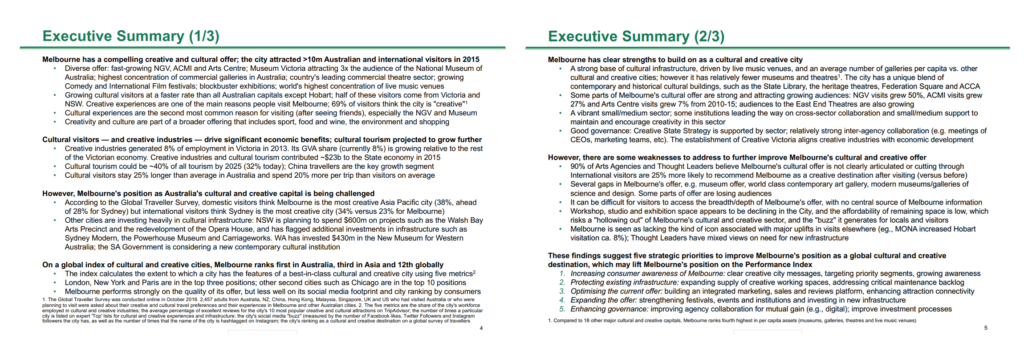
Good executive summaries follow three best practices:
- They are structured with bolded text for summary sentences and bullet points for supporting data. This ensures that every claim is clearly supported by data.
- The bolded summary sentences can be read alone to tell the slide’s storyline (i.e. you don’t need to read the supporting data in the bullet points).
- The bolded summary sentences reflect the SCR storyline structure of the slide deck
One other good practice (that you don’t see in the BCG example) is to reference the associated body slide throughout the executive summary. This helps direct a reader to the detailed analysis behind every claim in the executive summary.
Review your slide deck
Now that you’ve finished building all your slides and writing your executive summary, it’s time to review and finalize your slide deck.
There are three things that you need to check as you review your slide deck:
- Chart completeness : Check that your charts are comprehensively labeled, including chart titles, axis labels, units, time periods, etc.
- Text brevity : Review your slide text, including your lead-ins, and ensure that you make your points with the minimum number of words possible.
- Slide consistency : Review your slides and ensure that there is consistent formatting across the slides.
Reviewing your charts and visualizations
There’s a surprising amount of detail contained in charts and it’s quite easy to forget to key include key information.
Some examples of common charting mistakes include missing chart titles, labels, axes, units, dates, and legends. You should also consider how you highlights the implication of your charts.
To make this easier, you should use a charting checklist to methodically cross-reference your chart with best practice.
Refining your slide text
There’s an important place for text in slides. Not only can your use text to provide important context to support your visualizations, but also to communicate insights without data.
Most people use too many words in their slides. They tend to use fancy “consulting speak” or long, verbose explanations that actually obsure their message.
As you review your slide deck, you should review all of the text in your slides and savagely sharpen your text by removing unnecessary words .
Ensuring consistency across slides
Finally, you should use your last review to check for consistency across slides.
Start by ensuring that the formatting is consistent. For example, your slide format, spacing, fonts and slide numbers should all be consistent across the slides.
And then finish your review by ensuring all concepts are communicated consistently across slides. For example, if you’ve numbered or colored concepts a certain way, then ensure that they remain consistent throughout your slide deck.
Strategy Presentation: How to Successfully Develop and Communicate Your Corporate Strategies!
In the business world, it‘s pretty common to have to present your corporate strategy or internal strategies (e.g. a strategy presentation for a product launch) in front of an audience. Such strategy presentations are particularly important for start-ups, to set out the company’s vision and goals, and show the pathway there to both employees and stakeholders.
So this article is about how to skillfully develop a strategy, and how present it optimally.
Different types of strategy presentation
A strategy presentation does not necessarily have to be an all-encompassing corporate strategy. Strategies concerning internal company processes can also be presented within a strategy presentation. These can be, for example:
- Corporate Strategy
- Product Launch Strategy
- Marketing Strategy
- Human Resources Strategy
- Growth Strategy
- Social Media Strategy
- Finance Strategy
Developing Corporate Strategy
Every company needs a strategy for the company to grow. The corporate strategy forms a central element of management. By defining the strategy , internal company priorities are set and visions as well as goals are defined.
Note: Developing a company strategy takes time . Rushing the process can be seriously counterproductive.
The term “strategy” needs to be clarified first. Many confuse this with a goal, a vision, or the action necessary to achieve a goal . A strategy is made up of all of these . It represents a long-term plan that defines what you need to do to achieve your goals.
In order to develop a successful, future-oriented strategy, you need to consider a wide variety of aspects. The following questions will help you to develop a good strategy :
- What makes your company unique? What sets it apart from your competitors?
- How do you attract prospective customers?
- How can you market your company/product/idea?
- What’s the available budget?
- What is the personnel situation?
- What problems may arise in the implementation of certain operations?
- What are the strengths/weaknesses?
Working through these points will give you a solid foundation . Steps to help you find the right strategy :
Strategic planning is worthless – unless there is first a strategic vision .” John Naisbitt-US futurologist
Every business idea is based on a vision. What do you want to achieve with your company? What gap in the market do you want to fill? Define the purpose of your business. Define its exact reason for existing .
A company vision also includes a defined goal. This does not necessarily have to be financial. What do you want from your company in the future?
- The Competition

Any business idea normally has competitors offering something similar. It’s essential to analyze the market environment.
What trends are competitors following? How successful are they? What sales opportunities might you have with your idea?
When you have a start-up with new business ideas, market analysis can be extremely tricky. Lack of prior evidence makes it very challenging to estimate possible future success.
- Strengths and weaknesses
This is where you turn the spotlight on your company. What niche are you aiming for in the market? How many employees will you need and what is your current staffing situation? If you already have sales figures, how are they developing?
External consultants are often called in at this point to provide an unbiased assessment of your company. You can also use online tools for this assessment. Some of these are freely available and can give you a quick insight into your conversion rate, web analytics, etc. Once you have an assessment, you can use it as a basis to determine a strategic direction for your company.
Tools and methods to aid strategy development
There are various methods and tools which can help here:
- SWOT Analysis
SWOT analysis aims to determine the position of your company in the industry overall. Both internal company factors (strengths and weaknesses) and external aspects of business (risks and opportunities) are analyzed, and how the areas correlate with each other is considered.
SWOT analysis helps to sustainably leverage strengths and opportunities in order to minimize weaknesses and risks, aiming to maximize your company’s competitiveness in its field in the long term. SWOT analysis involves inputting measured facts about your company into a matrix, which results in a framework for action.
Use our professionally designed templates from our shop for the SWOT analysis!

- STEP Analysis / PEST Analysis
STEP/PEST analysis is a great tool for strategic planning of your company. This analysis involves four major factors of influence: Political (P), Economic (E), Social (S) and Technological (T).
Analyzing your company’s measurements on these seminal factors allows you to understand your market, develop targeted strategies and neutralize negative influences.
Looking for templates to apply STEP/PEST analysis and present your findings? We have professionally designed PowerPoint templates at your fingertips in our store !

- Other tools
There are many other tools that can be used to help refine your strategies; what you need will depend on your particular field. Our strategy toolbox contains a wide range of different strategy models for creating and visualizing your company’s strategies!

Why is PowerPoint so good for strategy presentations?
Microsoft Office PowerPoint’s easy-to-use user interface means that it allows you to visualize and present complex relationships in simple and clear format. A PowerPoint presentation allows you to present all the important information at a glance , meaning that decisions on open questions can be made quickly and conclusively.
Strategy presentations: what and how?
So you’ve developed your optimal strategy –now it’s time to present it. What’s the best way to get your strategy over effectively to your audience?
One of the most important things to bear in mind is that a strategy presentation is NOT just presenting a plan . You can’t just present a to-do list with a timeline attached. Your strategy is the underlying idea – explaining it is how you convince your audience that your plans are necessary.
Your strategy represents your guiding principle . Supporting your guiding principle by presenting facts and figures in a visually interesting way is very effective – using well-designed tables to present your key performance indicators, for example. As well as solid evidence-based slides to appeal to the intellect, though, you need to involve emotions to get your audience on side.
Tell a story , and weave your key facts and figures into it! We go into the whys and hows of this in our storytelling blog .
What slides should I put in a strategy presentation?
There is no one answer to this question – each strategy presentation is unique , so requires slides tailored specifically to the strategy.
However, the following basic pattern is useful as a guide:
- Slide #1: The task
The first slide you present should always be thoroughly thought through and well designed; it is the first impression your audience gets, and will influence how they feel about your ideas.
So, on the first slide, explain why you’re giving the presentation . State the goal or business problem around which the strategy was built. A great way to do this is by using a diagram or a picture, illustrating this visually. Then elaborate on the content as you speak – this way you can be sure that your audience is actually listening, and not just reading the content of your slide.
Don’t go into too much detail at this point. The idea is that your audience should understand the context of your strategy, and will then pay attention to what you have to say in the rest of the presentation.
- Slide #2: Insight
Your strategy is based on an insight; an idea which will move you towards your goal and away from your problem. Where possible, this will be backed up by solid research and market analyses. The insight slide presents the results of your market analysis .
Your narration then gets your point over to your audience. For example, if your slide states that: “In summer, Brand X light drinks have higher market share”, you can present your insight as “When it’s hot, people want refreshment, so will choose light drinks”.
It works best to use sentence form for the insight slide. Depending on who you’re presenting to, you may want to put exact numbers or trends you’ve identified before the insight sentence, to clarify the context. Even if you don’t include this data on the slide, you should have it prepared in the appendix of your presentation, in case there are any questions.
- Slide #3: Guiding principle
The guiding principle slide is the first slide to show your strategy. So it needs to be as persuasive as possible. Take your time choosing the wording and editing it. Your guiding principle, or mission statement, should be clear and concise , in plain, jargon-free English.
The choice of words is important because your mission statement needs to be memorable . Pay attention to the way the slide is designed, too – don’t overload the slide; keep the focus on the key phrase.
- Slide #4: Visual model
Your strategy is based on solving a problem, and showing how this might work. It is a pathway to the future success of your company, based on data and experience. To make this complex issue as understandable as possible, a visual model can help.
A model can show all the steps and actions needed, and which ones should be prioritized. It can also show how they can interact to achieve your goal.
You could, for example, represent your strategy as a diagram – think Venn diagrams, pyramids or a flywheel. There are so many options available! Why not head over to our store to find the perfect visual model for your strategy? ► Shop
Venn diagrams from PresentationLoad. Like all our PPT slide templates, professionally designed for you!
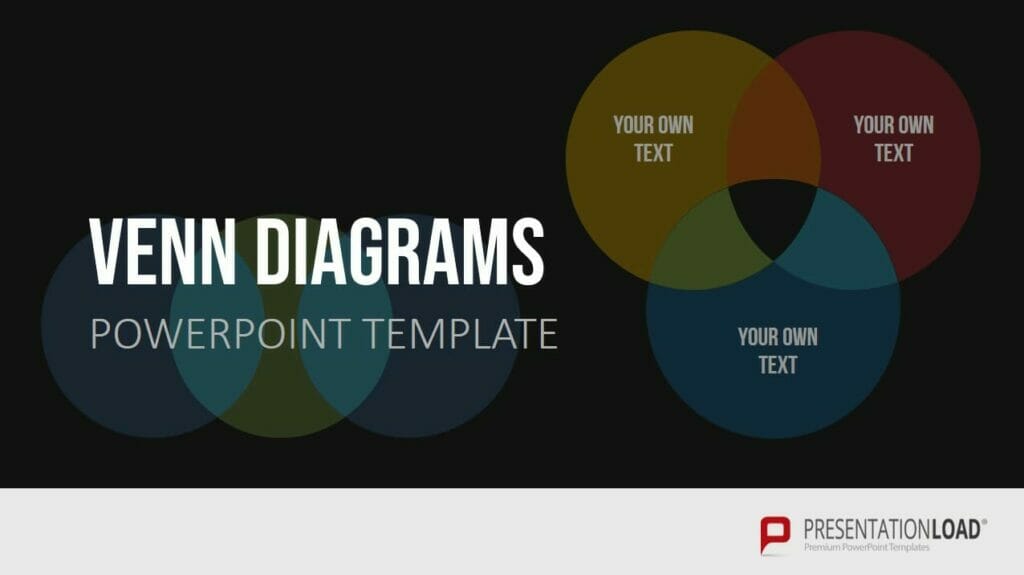
- Slide #5: Tactics
You might need more than one slide here, as you need here to include all the tactics you have planned to achieve your goals . Explain all the steps in detail , while staying clear and concise.
Your audience may well have questions during this section of the presentation. You’ll need to think through all the possibilities, and either answer them in the presentation or put further information in the presentation appendix, ready for you to retrieve on demand.
- Slide #6: Timeline
Timelines are essential during a strategy presentation to visually show the timing of specific tasks. Include the duration of different strategy phases as well as milestones you want to have achieved by specific dates. Show when you expect to have achieved your desired outcome.
Try to be as realistic as possible about your strategy.
Why not use PresentationLoad’s excellent timeline templates ? They are professionally designed for you. Have a look in our Shop! We have a range of different timeline templates for you to download. Like these:
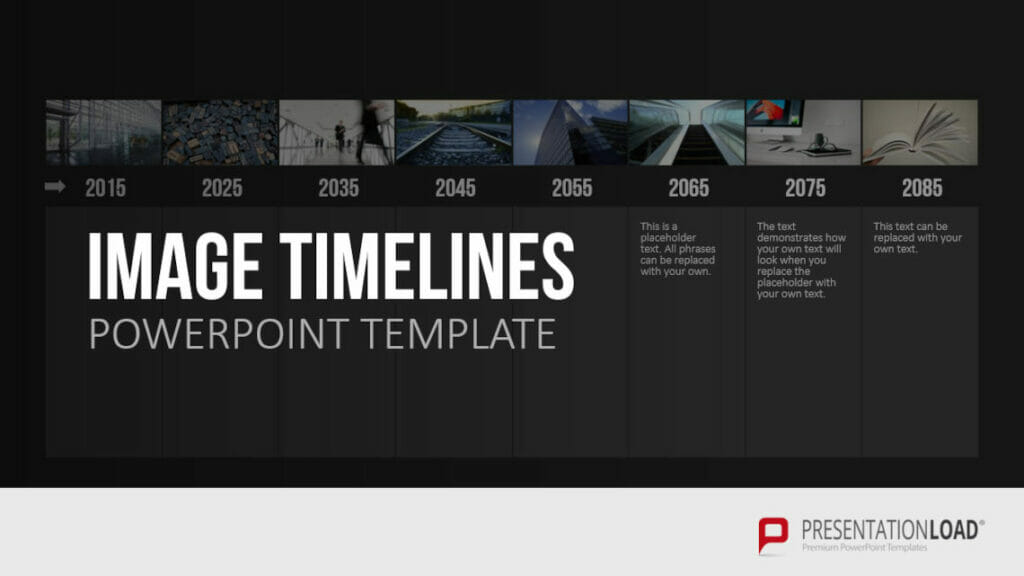
- Slide #7: Closing slide
As in any presentation, you need to pay particular attention to the last slide of your strategy presentation, as it’s the last thing your audience will see and hear from you and will stay in their minds. So make sure what they remember is the best you can give!
Briefly summarize the most important points again. This doesn’t mean an overloaded slide (remember, less is often more); you can verbally elaborate.
You might like to end with a relevant quote, representing your inspiration, or with a list of the immediate steps to take. Whatever you choose, it gets over that you stand behind your strategy and are positive about your company’s future .
Time for follow-up questions should also be planned at this point. Be prepared for detailed questions; you will demonstrate your competence and reassure your audience by being able to answer their questions, perhaps even with slides supporting your answers which you included in the appendix.
Extra tip: PRESENT your presentation professionally
It doesn’t matter how well your slides are designed and thought out if you come across as unprofessional and awkward when you present them. Your strategy presentation will only be taken seriously if you’re seen as competent, confident and self-assured . Don’t panic, though! We’ve covered this thoroughly in our blog just check out these articles and you’ll be able to present your strategy as professionally as possible:
- Body Language in Presentations
- Humor in Presentations
- PowerPoint Speaker View
- Storytelling in Presentations
- Public Speaking Skills for Presentations
- And many more
Conclusion: Now you know how to create and present the best strategy presentation!
Your next strategy presentation is going to be brilliant! Following our tips, it will be clear and well thought out, you will present it calmly and professionally, and your audience will be convinced, with the necessary strategic follow-up decisions made quickly and efficiently.
Have more questions about strategy presentations, or indeed PowerPoint in general? Feel free to email us at [email protected] . We’re always happy to help! Looking for professionally designed slide templates to support your strategy presentation? Check out our store! We have a huge range of PowerPoint slide templates ready to download, covering all the business topics you need. Take a look today! ► To our Shop
We’ve even developed PPT templates specifically for strategy presentations – professionally designed and ready to download and solve your presentation problems ► Strategy Presentations
You might also be interested in the following articles:
- Company Presentations with PowerPoint
- Short Presentation with PowerPoint
Share this post
- share
- save

Design Thinking: Problem Solving with a Difference

Why Corporate Mission Statements Are So Important

7 Tips & Learnings from the Apple Keynote
We use essential cookies to make Venngage work. By clicking “Accept All Cookies”, you agree to the storing of cookies on your device to enhance site navigation, analyze site usage, and assist in our marketing efforts.
Manage Cookies
Cookies and similar technologies collect certain information about how you’re using our website. Some of them are essential, and without them you wouldn’t be able to use Venngage. But others are optional, and you get to choose whether we use them or not.
Strictly Necessary Cookies
These cookies are always on, as they’re essential for making Venngage work, and making it safe. Without these cookies, services you’ve asked for can’t be provided.
Show cookie providers
- Google Login
Functionality Cookies
These cookies help us provide enhanced functionality and personalisation, and remember your settings. They may be set by us or by third party providers.
Performance Cookies
These cookies help us analyze how many people are using Venngage, where they come from and how they're using it. If you opt out of these cookies, we can’t get feedback to make Venngage better for you and all our users.
- Google Analytics
Targeting Cookies
These cookies are set by our advertising partners to track your activity and show you relevant Venngage ads on other sites as you browse the internet.
- Google Tag Manager
- Infographics
- Daily Infographics
- Graphic Design
- Graphs and Charts
- Data Visualization
- Human Resources
- Training and Development
- Beginner Guides
Blog Beginner Guides
How To Make a Good Presentation [A Complete Guide]
By Krystle Wong , Jul 20, 2023

A top-notch presentation possesses the power to drive action. From winning stakeholders over and conveying a powerful message to securing funding — your secret weapon lies within the realm of creating an effective presentation .
Being an excellent presenter isn’t confined to the boardroom. Whether you’re delivering a presentation at work, pursuing an academic career, involved in a non-profit organization or even a student, nailing the presentation game is a game-changer.
In this article, I’ll cover the top qualities of compelling presentations and walk you through a step-by-step guide on how to give a good presentation. Here’s a little tip to kick things off: for a headstart, check out Venngage’s collection of free presentation templates . They are fully customizable, and the best part is you don’t need professional design skills to make them shine!
These valuable presentation tips cater to individuals from diverse professional backgrounds, encompassing business professionals, sales and marketing teams, educators, trainers, students, researchers, non-profit organizations, public speakers and presenters.
No matter your field or role, these tips for presenting will equip you with the skills to deliver effective presentations that leave a lasting impression on any audience.
Click to jump ahead:
What are the 10 qualities of a good presentation?
Step-by-step guide on how to prepare an effective presentation, 9 effective techniques to deliver a memorable presentation, faqs on making a good presentation, how to create a presentation with venngage in 5 steps.
When it comes to giving an engaging presentation that leaves a lasting impression, it’s not just about the content — it’s also about how you deliver it. Wondering what makes a good presentation? Well, the best presentations I’ve seen consistently exhibit these 10 qualities:
1. Clear structure
No one likes to get lost in a maze of information. Organize your thoughts into a logical flow, complete with an introduction, main points and a solid conclusion. A structured presentation helps your audience follow along effortlessly, leaving them with a sense of satisfaction at the end.
Regardless of your presentation style , a quality presentation starts with a clear roadmap. Browse through Venngage’s template library and select a presentation template that aligns with your content and presentation goals. Here’s a good presentation example template with a logical layout that includes sections for the introduction, main points, supporting information and a conclusion:

2. Engaging opening
Hook your audience right from the start with an attention-grabbing statement, a fascinating question or maybe even a captivating anecdote. Set the stage for a killer presentation!
The opening moments of your presentation hold immense power – check out these 15 ways to start a presentation to set the stage and captivate your audience.
3. Relevant content
Make sure your content aligns with their interests and needs. Your audience is there for a reason, and that’s to get valuable insights. Avoid fluff and get straight to the point, your audience will be genuinely excited.
4. Effective visual aids
Picture this: a slide with walls of text and tiny charts, yawn! Visual aids should be just that—aiding your presentation. Opt for clear and visually appealing slides, engaging images and informative charts that add value and help reinforce your message.
With Venngage, visualizing data takes no effort at all. You can import data from CSV or Google Sheets seamlessly and create stunning charts, graphs and icon stories effortlessly to showcase your data in a captivating and impactful way.

5. Clear and concise communication
Keep your language simple, and avoid jargon or complicated terms. Communicate your ideas clearly, so your audience can easily grasp and retain the information being conveyed. This can prevent confusion and enhance the overall effectiveness of the message.
6. Engaging delivery
Spice up your presentation with a sprinkle of enthusiasm! Maintain eye contact, use expressive gestures and vary your tone of voice to keep your audience glued to the edge of their seats. A touch of charisma goes a long way!
7. Interaction and audience engagement
Turn your presentation into an interactive experience — encourage questions, foster discussions and maybe even throw in a fun activity. Engaged audiences are more likely to remember and embrace your message.
Transform your slides into an interactive presentation with Venngage’s dynamic features like pop-ups, clickable icons and animated elements. Engage your audience with interactive content that lets them explore and interact with your presentation for a truly immersive experience.

8. Effective storytelling
Who doesn’t love a good story? Weaving relevant anecdotes, case studies or even a personal story into your presentation can captivate your audience and create a lasting impact. Stories build connections and make your message memorable.
A great presentation background is also essential as it sets the tone, creates visual interest and reinforces your message. Enhance the overall aesthetics of your presentation with these 15 presentation background examples and captivate your audience’s attention.
9. Well-timed pacing
Pace your presentation thoughtfully with well-designed presentation slides, neither rushing through nor dragging it out. Respect your audience’s time and ensure you cover all the essential points without losing their interest.
10. Strong conclusion
Last impressions linger! Summarize your main points and leave your audience with a clear takeaway. End your presentation with a bang , a call to action or an inspiring thought that resonates long after the conclusion.
In-person presentations aside, acing a virtual presentation is of paramount importance in today’s digital world. Check out this guide to learn how you can adapt your in-person presentations into virtual presentations .

Preparing an effective presentation starts with laying a strong foundation that goes beyond just creating slides and notes. One of the quickest and best ways to make a presentation would be with the help of a good presentation software .
Otherwise, let me walk you to how to prepare for a presentation step by step and unlock the secrets of crafting a professional presentation that sets you apart.
1. Understand the audience and their needs
Before you dive into preparing your masterpiece, take a moment to get to know your target audience. Tailor your presentation to meet their needs and expectations , and you’ll have them hooked from the start!
2. Conduct thorough research on the topic
Time to hit the books (or the internet)! Don’t skimp on the research with your presentation materials — dive deep into the subject matter and gather valuable insights . The more you know, the more confident you’ll feel in delivering your presentation.
3. Organize the content with a clear structure
No one wants to stumble through a chaotic mess of information. Outline your presentation with a clear and logical flow. Start with a captivating introduction, follow up with main points that build on each other and wrap it up with a powerful conclusion that leaves a lasting impression.
Delivering an effective business presentation hinges on captivating your audience, and Venngage’s professionally designed business presentation templates are tailor-made for this purpose. With thoughtfully structured layouts, these templates enhance your message’s clarity and coherence, ensuring a memorable and engaging experience for your audience members.
Don’t want to build your presentation layout from scratch? pick from these 5 foolproof presentation layout ideas that won’t go wrong.

4. Develop visually appealing and supportive visual aids
Spice up your presentation with eye-catching visuals! Create slides that complement your message, not overshadow it. Remember, a picture is worth a thousand words, but that doesn’t mean you need to overload your slides with text.
Well-chosen designs create a cohesive and professional look, capturing your audience’s attention and enhancing the overall effectiveness of your message. Here’s a list of carefully curated PowerPoint presentation templates and great background graphics that will significantly influence the visual appeal and engagement of your presentation.
5. Practice, practice and practice
Practice makes perfect — rehearse your presentation and arrive early to your presentation to help overcome stage fright. Familiarity with your material will boost your presentation skills and help you handle curveballs with ease.
6. Seek feedback and make necessary adjustments
Don’t be afraid to ask for help and seek feedback from friends and colleagues. Constructive criticism can help you identify blind spots and fine-tune your presentation to perfection.
With Venngage’s real-time collaboration feature , receiving feedback and editing your presentation is a seamless process. Group members can access and work on the presentation simultaneously and edit content side by side in real-time. Changes will be reflected immediately to the entire team, promoting seamless teamwork.

7. Prepare for potential technical or logistical issues
Prepare for the unexpected by checking your equipment, internet connection and any other potential hiccups. If you’re worried that you’ll miss out on any important points, you could always have note cards prepared. Remember to remain focused and rehearse potential answers to anticipated questions.
8. Fine-tune and polish your presentation
As the big day approaches, give your presentation one last shine. Review your talking points, practice how to present a presentation and make any final tweaks. Deep breaths — you’re on the brink of delivering a successful presentation!
In competitive environments, persuasive presentations set individuals and organizations apart. To brush up on your presentation skills, read these guides on how to make a persuasive presentation and tips to presenting effectively .

Whether you’re an experienced presenter or a novice, the right techniques will let your presentation skills soar to new heights!
From public speaking hacks to interactive elements and storytelling prowess, these 9 effective presentation techniques will empower you to leave a lasting impression on your audience and make your presentations unforgettable.
1. Confidence and positive body language
Positive body language instantly captivates your audience, making them believe in your message as much as you do. Strengthen your stage presence and own that stage like it’s your second home! Stand tall, shoulders back and exude confidence.
2. Eye contact with the audience
Break down that invisible barrier and connect with your audience through their eyes. Maintaining eye contact when giving a presentation builds trust and shows that you’re present and engaged with them.
3. Effective use of hand gestures and movement
A little movement goes a long way! Emphasize key points with purposeful gestures and don’t be afraid to walk around the stage. Your energy will be contagious!
4. Utilize storytelling techniques
Weave the magic of storytelling into your presentation. Share relatable anecdotes, inspiring success stories or even personal experiences that tug at the heartstrings of your audience. Adjust your pitch, pace and volume to match the emotions and intensity of the story. Varying your speaking voice adds depth and enhances your stage presence.

5. Incorporate multimedia elements
Spice up your presentation with a dash of visual pizzazz! Use slides, images and video clips to add depth and clarity to your message. Just remember, less is more—don’t overwhelm them with information overload.
Turn your presentations into an interactive party! Involve your audience with questions, polls or group activities. When they actively participate, they become invested in your presentation’s success. Bring your design to life with animated elements. Venngage allows you to apply animations to icons, images and text to create dynamic and engaging visual content.
6. Utilize humor strategically
Laughter is the best medicine—and a fantastic presentation enhancer! A well-placed joke or lighthearted moment can break the ice and create a warm atmosphere , making your audience more receptive to your message.
7. Practice active listening and respond to feedback
Be attentive to your audience’s reactions and feedback. If they have questions or concerns, address them with genuine interest and respect. Your responsiveness builds rapport and shows that you genuinely care about their experience.

8. Apply the 10-20-30 rule
Apply the 10-20-30 presentation rule and keep it short, sweet and impactful! Stick to ten slides, deliver your presentation within 20 minutes and use a 30-point font to ensure clarity and focus. Less is more, and your audience will thank you for it!
9. Implement the 5-5-5 rule
Simplicity is key. Limit each slide to five bullet points, with only five words per bullet point and allow each slide to remain visible for about five seconds. This rule keeps your presentation concise and prevents information overload.
Simple presentations are more engaging because they are easier to follow. Summarize your presentations and keep them simple with Venngage’s gallery of simple presentation templates and ensure that your message is delivered effectively across your audience.

1. How to start a presentation?
To kick off your presentation effectively, begin with an attention-grabbing statement or a powerful quote. Introduce yourself, establish credibility and clearly state the purpose and relevance of your presentation.
2. How to end a presentation?
For a strong conclusion, summarize your talking points and key takeaways. End with a compelling call to action or a thought-provoking question and remember to thank your audience and invite any final questions or interactions.
3. How to make a presentation interactive?
To make your presentation interactive, encourage questions and discussion throughout your talk. Utilize multimedia elements like videos or images and consider including polls, quizzes or group activities to actively involve your audience.
In need of inspiration for your next presentation? I’ve got your back! Pick from these 120+ presentation ideas, topics and examples to get started.
Creating a stunning presentation with Venngage is a breeze with our user-friendly drag-and-drop editor and professionally designed templates for all your communication needs.
Here’s how to make a presentation in just 5 simple steps with the help of Venngage:
Step 1: Sign up for Venngage for free using your email, Gmail or Facebook account or simply log in to access your account.
Step 2: Pick a design from our selection of free presentation templates (they’re all created by our expert in-house designers).
Step 3: Make the template your own by customizing it to fit your content and branding. With Venngage’s intuitive drag-and-drop editor, you can easily modify text, change colors and adjust the layout to create a unique and eye-catching design.
Step 4: Elevate your presentation by incorporating captivating visuals. You can upload your images or choose from Venngage’s vast library of high-quality photos, icons and illustrations.
Step 5: Upgrade to a premium or business account to export your presentation in PDF and print it for in-person presentations or share it digitally for free!
By following these five simple steps, you’ll have a professionally designed and visually engaging presentation ready in no time. With Venngage’s user-friendly platform, your presentation is sure to make a lasting impression. So, let your creativity flow and get ready to shine in your next presentation!
How to make a great presentation
Stressed about an upcoming presentation? These talks are full of helpful tips on how to get up in front of an audience and make a lasting impression.

The secret structure of great talks

The beauty of data visualization

TED's secret to great public speaking

How to speak so that people want to listen

How great leaders inspire action
Strategic planning presentation: A comprehensive guide
Learn everything from defining your mission to creating an action plan.
Raja Bothra
Building presentations

In this comprehensive guide, we'll delve deep into the world of strategic planning presentations, uncovering the strategies, models, and key performance indicators (KPIs) that drive businesses forward.
So, let's embark on this journey to demystify the art of strategic planning presentations.
What is strategic planning, and why is it important?
Before we dive into the nitty-gritty of strategic planning presentations, let's establish a clear understanding of what strategic planning entails. At its core, strategic planning is the process through which an organization defines its objectives, evaluates its resources, and charts a course of action to achieve its long-term goals. It's like the roadmap that guides a business toward its desired future.
Strategic planning is crucial for several reasons. First and foremost, it provides a sense of direction. In the ever-evolving business landscape, having a well-defined strategic plan is akin to having a North Star to navigate by. It ensures that all stakeholders are aligned with the organization's vision and mission, fostering unity and a shared purpose.
Moreover, strategic planning allows businesses to anticipate and adapt to changes in the market. It's not enough to have a great product or service; you must also have a strategy to stay ahead of the competition. In this dynamic environment, being proactive rather than reactive is key to survival.
Strategic planning models
Now that we've established the importance of strategic planning, let's explore some strategic planning models that can serve as valuable frameworks for your presentations. These models are like tools in your strategic toolkit, each offering a unique approach to the planning process.
- SWOT analysis : This classic model helps businesses assess their strengths , weaknesses , opportunities , and threats . It's a powerful tool for identifying internal and external factors that can impact your strategic decisions.
- The strategic planning process : This model provides a step-by-step guide to the entire strategic planning process , from setting objectives to implementation and evaluation. It's like a well-structured action plan for your business's future.
- Strategy development : Developing a sound business strategy is at the heart of strategic planning. This model offers insights into crafting a winning strategy that aligns with your organization's goals and resources.
- Gap analysis : Want to bridge the divide between your current state and your desired future state? Gap analysis is the model for you. It helps you pinpoint the disparities and devise strategies to close the gap effectively.
- The strategy map : This model helps you visualize your strategy by creating a graphical representation of your goals, objectives, and the causal relationships between them. It's a fantastic way to convey complex ideas in a simple, visually appealing manner.
KPIs and metrics to add in strategic plan presentation
As the saying goes, " What gets measured gets managed. " In strategic planning presentations, KPIs (Key Performance Indicators) and metrics are your guiding lights. These quantifiable measures provide insights into the health and progress of your strategic initiatives. Here are some essential KPIs and metrics to consider including in your presentation:
- Revenue growth : One of the fundamental KPIs, revenue growth , indicates the financial health of your organization. It reflects the effectiveness of your strategies in generating income.
- Customer acquisition cost (CAC) : Understanding how much it costs to acquire a new customer is vital. A high CAC can eat into your profits, so presenting strategies to reduce it can be a game-changer.
- Customer lifetime value (CLV) : This metric gauges the long-term value of a customer to your business. A higher CLV often signifies effective customer retention strategies.
- Market share : For many businesses, market share is a critical KPI. It measures your share of the market compared to competitors, showing your industry presence.
- Return on investment (ROI) : ROI quantifies the profitability of your investments. A positive ROI indicates that your strategies are generating more revenue than they cost.
- Employee satisfaction : Don't forget about your internal stakeholders. Employee satisfaction can impact productivity and customer service, making it a valuable metric to track.
How to structure an effective strategic planning presentation
Now that you have a grasp of the models and metrics, let's focus on the structure of your strategic planning presentation. Remember, a well-structured presentation not only conveys your ideas effectively but also keeps your audience engaged. Here's a tried-and-true structure to consider:
1. Title slide
- Begin your presentation with a compelling title that piques interest.
- Introduce yourself and your role in the organization.
2. Agenda slide
- Provide a clear outline of what your presentation will cover.
3. Executive summary
- Summarize the key points of your strategic plan.
- Highlight the most critical objectives and strategies.
4. Business overview
- Give an overview of your organization, its mission, and its current position in the market.
- Use visuals like charts and graphs to make data more digestible.
5. Strategic objectives
- Present your strategic objectives clearly and concisely.
- Use the SMART (Specific, Measurable, Achievable, Relevant, Time-bound) criteria to define your objectives.
6. Strategies and tactics
- Dive into the heart of your plan by detailing your strategies and tactics .
- Use visuals and real-world examples to illustrate your points.

7. KPIs and metrics
- Show how you'll measure success using the KPIs and metrics we discussed earlier.
- Use charts and graphs to make data visually appealing.
8. Implementation plan
- Explain how you'll put your strategies into action.
- Include a timeline to show the sequence of events.
9. Risk assessment
- Address potential threats and constraints that could impact your plan.
- Highlight contingency plans to mitigate these risks.
10. Conclusion
- Summarize the key takeaways from your presentation.
- End with a strong call to action or next steps.
11. Q&A
- Open the floor to questions and engage with your audience.
- Be prepared to provide detailed answers to ensure buy-in from stakeholders.
Do's and don'ts of a strategic planning presentation
- Clear and concise : Avoid jargon and keep your language simple and understandable.
- Visuals : Visual aids like charts, graphs, and diagrams can clarify complex ideas.
- Practice : Rehearse your presentation to ensure a smooth delivery.
- Engage your audience : Encourage questions and discussions to foster understanding and buy-in .
- Adaptable : Be prepared to adjust your presentation based on your audience's level of expertise and interest.
Don'ts:
- Overwhelm with data : While data is essential, don't drown your audience in it. Select the most relevant information.
- Rush : Take your time to explain key points and concepts.
- Overconfident : Be open to feedback and willing to adjust your plan if necessary.
- Neglect the human element : Remember that your presentation is not just about data; it's also about convincing your audience to support your plan.
Summarizing key takeaways
- Strategic planning : It's your roadmap for long-term success, providing direction and adaptability.
- Models matter : Use models like SWOT analysis, strategic planning processes, and more to structure your presentations effectively.
- Metrics count : Include KPIs like revenue growth, CAC, CLV, market share, and ROI for measuring success.
- Structure matters : Create presentations with a clear agenda, engaging content, and a strong conclusion.
- Presentation do's and don'ts : Be clear, use visuals, practice, engage your audience, and stay adaptable. Avoid data overload, rushing, overconfidence, and neglecting your audience.
1. What is a strategic planning presentation, and how can I create one efficiently?
A strategic planning presentation is a vital tool for conveying your organization's long-term vision and goals. It's a roadmap that outlines your business plan, competitive advantage, and strategy for success. To create one efficiently, consider using Prezent, PowerPoint or Google Slides, as they offer editable templates designed for strategic management presentations. These customizable templates help streamline the process, allowing you to focus on developing a strategic plan rather than formatting slides from scratch.
2. What should I include in a strategic planning presentation?
In your strategy presentation, cover essential components such as your mission statement, vision statement, and a detailed strategic plan with clear, actionable goals and action plans. Use slide templates to organize your content effectively within a planning framework. Be sure to highlight your organization's unique competitive advantage and address the potential imitability of your strategy. Additionally, incorporate business diagrams and analysis to support your points and make your presentation high-quality and informative.
3. Can I use PowerPoint and Google Slides for my strategic planning presentation?
Yes, you can leverage both PowerPoint and Google Slides for your strategy presentation. They offer professionally designed templates that are fully customizable, making it easier to allocate your content and create an efficient strategy slideshow. Whether you prefer one page, PPT or Google Slides, you have the flexibility to develop and edit your presentation collaboratively online and save it in various formats, including PDF.
4. How often should I update my strategic planning presentation?
Your strategic planning presentation may change over time as your business evolves. It's advisable to review and update it regularly, especially when significant developments occur or during pivotal moments like a product launch or changes in strategic direction. Ensure that your presentation reflects your organization's current goals, strategies, and execution plans to maintain its relevance and effectiveness.
5. What role do professionally designed templates play in a strategic planning presentation?
Professionally designed templates are instrumental in creating an efficient and visually appealing strategy planning powerpoint presentation. These pre-designed templates offer a scheme that organizes your content logically, making it easier to brainstorm and communicate your organization's process effectively. With high-quality, customizable templates, you can convey your strategy clearly, emphasizing your competitive advantage and ensuring your audience understands your business plan.
Create your strategic planning presentation with prezent
Prezent revolutionizes the creation of strategic planning presentations with its comprehensive suite of features. It starts by saving you a remarkable 70% of the time typically spent on crafting presentations. With access to a vast library of over 35,000 slides and brand-approved designs, Prezent ensures that your presentation is not only visually appealing but also 100% on brand, aligning perfectly with your company's image.
Additionally, it crushes 60% of communication costs, making it a cost-effective solution. Prezent allows you to consider audience preferences, personalize content, and collaborate in real-time, enabling your team to work seamlessly together. Its overnight presentation service ensures you meet tight deadlines with ease, further enhancing your strategic planning process.
So, go ahead, create your strategic planning presentation, and steer your organization toward a future filled with success and sustainability.
Are you ready to power up your strategic planning presentations? Try our free trial or book a demo today with Prezent!
Get the latest from Prezent community
Join thousands of subscribers who receive our best practices on communication, storytelling, presentation design, and more. New tips weekly. (No spam, we promise!)
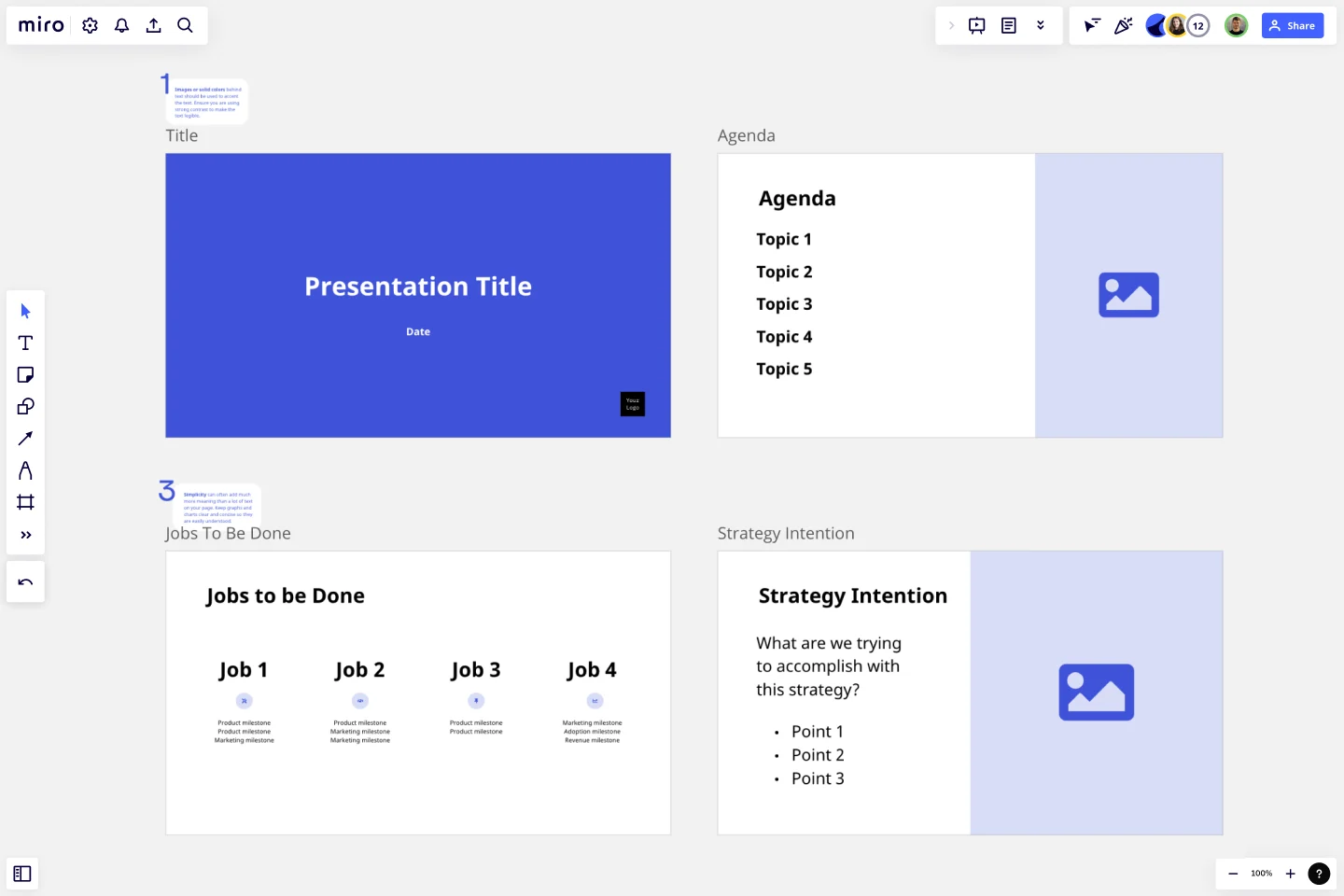
Strategy Presentation Template
Present the key points of your strategy using a Strategy Presentation Template. Ensure that your team understands the direction to take and how to execute plans.
Trusted by 65M+ users and leading companies
About the Strategy Presentation Template
This Strategy Presentation Template helps transform strategic ideas and thinking into actionable plans. With a clear template, you can present a strategy to your team to ensure that everyone is on the same page about where your business is heading.
Visual learning is a great way to engage employees and get them on board with never-before-seen ideas. The Miro Strategy Presentation Template will ensure that everyone listening understands the strategy presented and has a clear idea of the role they’ll play.
What’s a strategy presentation?
Strategies are the ideas and approaches business leaders map out to secure the future of a company. A strategy isn’t a plan. Rather, it’s a list of methods your team will use to achieve the company goals. These tactics refer to the what, how, and why of certain ideas to get everyone on board with the moves your team will make.
Presenting your strategies is the best way to allow people to understand what the business will focus on in the future. Strategies are often more abstract than concrete plans.
So, being able to discuss and present them to an audience can be challenging. A well-structured presentation is a great way to get employees to understand their roles and responsibilities in applying future strategies.
What should be in a strategy presentation?
The success of a presentation depends on the content included in it. It must be holistic, easy to understand, and flow well to keep listeners engaged. Your strategy presentation should:
Discuss the big picture. The big picture should be your starting point for your strategy presentation. The overall goals and aims of your business should guide your strategies and provide an overview of the end goal. It’s important that listeners learn about this overarching approach to understand the rationale behind certain strategies.
Focus on the “why” of each strategy. It’s important that the team members involved in the strategy execution understand the “why” behind the business strategy. This will motivate and direct them as they complete their specific tasks within the overall strategy.
Benefits of a strategy presentation
The following are the biggest advantages of a strategy presentation:
It establishes a sense of direction. The main benefit of a strategy presentation is to bring everyone in the business on board with the company’s direction and goals. It’s important that everyone understands this direction to work collaboratively and effectively to achieve the strategic goals.
It improves focus within the team. A strategy presentation helps everyone understand the business objectives and key results , the actions they need to take to deliver the strategy, and their role in the business’s success. Based on this critical information, employees and workers will focus more on the tasks they need to complete.
It presents information visually. A strategy presentation is an effective way to visually communicate ideas to everyone on your team. Technical speeches with a lot of business jargon might be difficult for some to understand, but a strategy presentation template can help.
How to use the Strategy Presentation Template
Here’s how to use this template to effectively communicate and present your strategy:
1. Fill in the frames with your strategy information
The Strategy Presentation Template has frames that act like editable slides for your presentation. Start by filling in each frame with the key information regarding your strategy. From the big picture and individual strategies to roles and jobs to be done, it’s important that you include all the ideas you want to discuss.
2. Customize the template
One of the main benefits of using this template is its flexibility. If certain frames don’t suit the message you want to convey, you can easily remove slides or edit them to suit your needs. You can move frames, arrange content on frames in a grid-like mode, and hide content on frames from your collaborators’ view. The frames are easy to manipulate, and the template is set up in a way that makes it easy to jump between slides to facilitate discussion and collaboration.
3. Use presentation mode
Once you’ve organized the information on each frame, it’s time to present. After entering full-screen presentation mode , use the arrow icons or arrow keys to navigate between frames as you showcase your strategy like a professional.
4. Get feedback
Developing a strategy should be a collaborative process. It’s easy to share your strategy presentation with the rest of your team by creating a link or adding others as collaborators. Share your slides and get feedback anytime, anywhere.
How to pull off a great strategy presentation
Presentations can be daunting, and getting your message across isn’t always an easy task. Keep the following tips in mind to help your strategy presentation communicate your strategic ideas effectively:
Make sure your insight is focused
Before you start thinking about presenting your company strategy, it’s important that your information is well researched and focused. It must not be scatterbrained, and claims must not be made without research to back them up. This is where you must collaborate with different people in your business to understand their opinions. You should also have a clear picture of the positions within the company and the role each person plays in carrying out the strategies.
Communicate the principles
The listeners of your presentation should understand the principles the strategy is based on. For example, if a strategy is focused on increasing productivity using a certain method, the principles of that method should be discussed. This brings it back to the “why.” The “why” must be explained and discussed throughout the presentation for your strategy to be properly received.
How do you start a business presentation strategy?
The best way to start a business presentation strategy is to discuss the job at hand. In other words, the presentation should start with the problem that needs to be solved. After this problem is understood and discussed, move on to the strategies that will be employed to solve it. After the introduction, this is the best way to engage the audience and make sure they understand the entire picture.
How do you structure a strategy presentation?
Having a well-structured strategy presentation is key to maintaining your audience’s attention and getting your point across. Begin by discussing the problem that needs solving. Secondly, discuss the principles that will underpin the strategies to be discussed later — the “why.” Lastly, after listeners begin thinking about solutions to the problem, present your ideas and tactics. This lends itself to a brainstorming and collaboration session.
When do you use a strategy presentation?
Strategy presentations can be used in any business sector that needs a revamp or has a problem that needs to be solved. For example, if your company wants to boost its online presence, it might be helpful to plan a social media strategy presentation. These strategic planning presentations can be used in all aspects of your business, from expansion to improving customer experience.
Get started with this template right now.
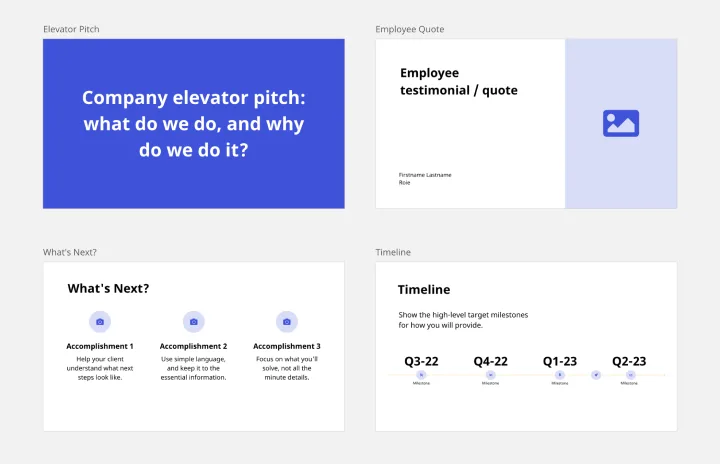
Company Vision Presentation Template
Works best for:.
Presentations, Business Management
Creating or reimagining a company vision is just half the battle. You also need to make sure that your employees and customers understand and share it. Communicate your vision statement in the most effective and concise way with this Company Vision Presentation Template.
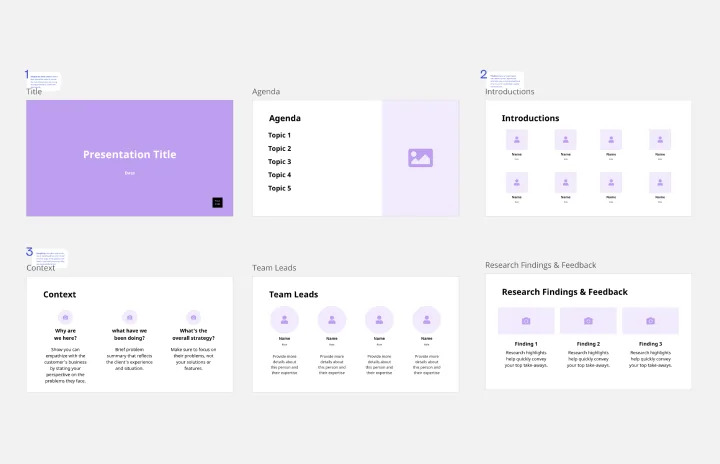
Demo Presentation Template
Presentations, Meetings
Present your ideas confidently and professionally with this Demo Presentation Template. Use it to show potential and existing customers how your product or service works so they can fully appreciate its value.
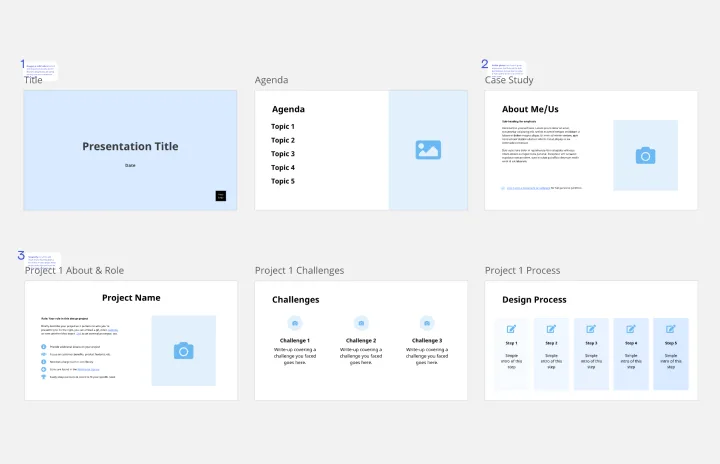
Portfolio Presentation Template
Presentations, UX Design
Display your work in an engaging and visually-appealing format with Miro’s Portfolio Presentation Template. Exhibit your best work and help your audience visualize your designs.

QBR Presentation Template
Use Miro’s QBR Presentation Template to give clients an overview of their business performance and show where you can add more value. Review your successes over the past 90 days and create a plan of action for the next quarter.

Project Presentation Template
Presentations, Product Management
Use our Project Presentation Template to provide an overview of your upcoming project. Get buy-in from investors, keep stakeholders in the loop, and show colleagues your plan of action.
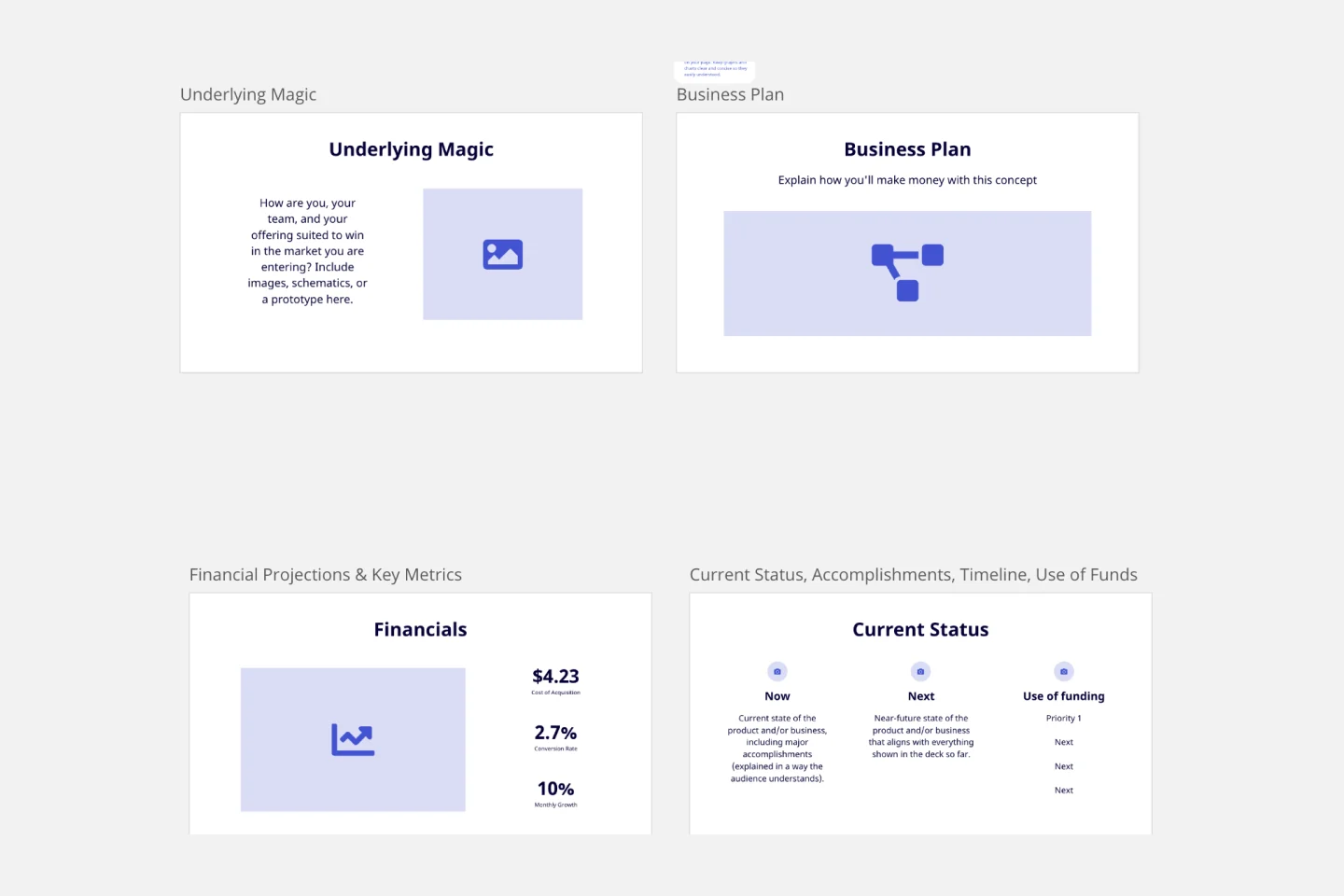
Pitch Deck Template
Stand out and leave a lasting impression with the Pitch Deck Template. Make people care about your idea and gain supporters everywhere.

- PRESENTATION SKILLS
Top Tips for Effective Presentations
Search SkillsYouNeed:
Presentation Skills:
- A - Z List of Presentation Skills
- General Presentation Skills
- What is a Presentation?
- Preparing for a Presentation
- Organising the Material
- Writing Your Presentation
- Deciding the Presentation Method
- Managing your Presentation Notes
- Working with Visual Aids
- Presenting Data
- Managing the Event
- Coping with Presentation Nerves
- Dealing with Questions
- How to Build Presentations Like a Consultant
- 7 Qualities of Good Speakers That Can Help You Be More Successful
- Self-Presentation in Presentations
- Specific Presentation Events
- Remote Meetings and Presentations
- Giving a Speech
- Presentations in Interviews
- Presenting to Large Groups and Conferences
- Giving Lectures and Seminars
- Managing a Press Conference
- Attending Public Consultation Meetings
- Managing a Public Consultation Meeting
- Crisis Communications
- Elsewhere on Skills You Need:
- Communication Skills
- Facilitation Skills
- Teams, Groups and Meetings
- Effective Speaking
- Question Types
Subscribe to our FREE newsletter and start improving your life in just 5 minutes a day.
You'll get our 5 free 'One Minute Life Skills' and our weekly newsletter.
We'll never share your email address and you can unsubscribe at any time.
How can you make a good presentation even more effective?
This page draws on published advice from expert presenters around the world, which will help to take your presentations from merely ‘good’ to ‘great’.
By bringing together advice from a wide range of people, the aim is to cover a whole range of areas.
Whether you are an experienced presenter, or just starting out, there should be ideas here to help you to improve.
1. Show your Passion and Connect with your Audience
It’s hard to be relaxed and be yourself when you’re nervous.
But time and again, the great presenters say that the most important thing is to connect with your audience, and the best way to do that is to let your passion for the subject shine through.
Be honest with the audience about what is important to you and why it matters.
Be enthusiastic and honest, and the audience will respond.
2. Focus on your Audience’s Needs
Your presentation needs to be built around what your audience is going to get out of the presentation.
As you prepare the presentation, you always need to bear in mind what the audience needs and wants to know, not what you can tell them.
While you’re giving the presentation, you also need to remain focused on your audience’s response, and react to that.
You need to make it easy for your audience to understand and respond.
3. Keep it Simple: Concentrate on your Core Message
When planning your presentation, you should always keep in mind the question:
What is the key message (or three key points) for my audience to take away?
You should be able to communicate that key message very briefly.
Some experts recommend a 30-second ‘elevator summary’, others that you can write it on the back of a business card, or say it in no more than 15 words.
Whichever rule you choose, the important thing is to keep your core message focused and brief.
And if what you are planning to say doesn’t contribute to that core message, don’t say it.
4. Smile and Make Eye Contact with your Audience
This sounds very easy, but a surprisingly large number of presenters fail to do it.
If you smile and make eye contact, you are building rapport , which helps the audience to connect with you and your subject. It also helps you to feel less nervous, because you are talking to individuals, not to a great mass of unknown people.
To help you with this, make sure that you don’t turn down all the lights so that only the slide screen is visible. Your audience needs to see you as well as your slides.
5. Start Strongly
The beginning of your presentation is crucial. You need to grab your audience’s attention and hold it.
They will give you a few minutes’ grace in which to entertain them, before they start to switch off if you’re dull. So don’t waste that on explaining who you are. Start by entertaining them.
Try a story (see tip 7 below), or an attention-grabbing (but useful) image on a slide.
6. Remember the 10-20-30 Rule for Slideshows
This is a tip from Guy Kawasaki of Apple. He suggests that slideshows should:
- Contain no more than 10 slides;
- Last no more than 20 minutes; and
- Use a font size of no less than 30 point.
This last is particularly important as it stops you trying to put too much information on any one slide. This whole approach avoids the dreaded ‘Death by PowerPoint’.
As a general rule, slides should be the sideshow to you, the presenter. A good set of slides should be no use without the presenter, and they should definitely contain less, rather than more, information, expressed simply.
If you need to provide more information, create a bespoke handout and give it out after your presentation.
7. Tell Stories
Human beings are programmed to respond to stories.
Stories help us to pay attention, and also to remember things. If you can use stories in your presentation, your audience is more likely to engage and to remember your points afterwards. It is a good idea to start with a story, but there is a wider point too: you need your presentation to act like a story.
Think about what story you are trying to tell your audience, and create your presentation to tell it.
Finding The Story Behind Your Presentation
To effectively tell a story, focus on using at least one of the two most basic storytelling mechanics in your presentation:
Focusing On Characters – People have stories; things, data, and objects do not. So ask yourself “who” is directly involved in your topic that you can use as the focal point of your story.
For example, instead of talking about cars (your company’s products), you could focus on specific characters like:
- The drivers the car is intended for – people looking for speed and adventure
- The engineers who went out of their way to design the most cost-effective car imaginable
A Changing Dynamic – A story needs something to change along the way. So ask yourself “What is not as it should be?” and answer with what you are going to do about it (or what you did about it).
For example…
- Did hazardous road conditions inspire you to build a rugged, all-terrain jeep that any family could afford?
- Did a complicated and confusing food labelling system lead you to establish a colour-coded nutritional index so that anybody could easily understand it?
To see 15 more actionable storytelling tips, see Nuts & Bolts Speed Training’s post on Storytelling Tips .
8. Use your Voice Effectively
The spoken word is actually a pretty inefficient means of communication, because it uses only one of your audience’s five senses. That’s why presenters tend to use visual aids, too. But you can help to make the spoken word better by using your voice effectively.
Varying the speed at which you talk, and emphasising changes in pitch and tone all help to make your voice more interesting and hold your audience’s attention.
For more about this, see our page on Effective Speaking .
9. Use your Body Too
It has been estimated that more than three quarters of communication is non-verbal.
That means that as well as your tone of voice, your body language is crucial to getting your message across. Make sure that you are giving the right messages: body language to avoid includes crossed arms, hands held behind your back or in your pockets, and pacing the stage.
Make your gestures open and confident, and move naturally around the stage, and among the audience too, if possible.
10. Relax, Breathe and Enjoy
If you find presenting difficult, it can be hard to be calm and relaxed about doing it.
One option is to start by concentrating on your breathing. Slow it down, and make sure that you’re breathing fully. Make sure that you continue to pause for breath occasionally during your presentation too.
For more ideas, see our page on Coping with Presentation Nerves .
If you can bring yourself to relax, you will almost certainly present better. If you can actually start to enjoy yourself, your audience will respond to that, and engage better. Your presentations will improve exponentially, and so will your confidence. It’s well worth a try.
Improve your Presentation Skills
Follow our guide to boost your presentation skills learning about preparation, delivery, questions and all other aspects of giving effective presentations.
Start with: What is a Presentation?
Continue to: How to Give a Speech Self Presentation
See also: Five Ways You Can Do Visual Marketing on a Budget Can Presentation Science Improve Your Presentation? Typography – It’s All About the Message in Your Slides
- Google Slides Presentation Design
- Pitch Deck Design
- Powerpoint Redesign
- Other Design Services

- Business Slides
- Guide & How to's
Stunning strategy plan presentation to turn your slides into a story
Communicating your strategic plan is equally as important as creating it. If your internal and external stakeholders do not understand your strategic direction, what’s the point of having and presenting one? In this five-minute read, we’ll discuss the peculiarities of a business strategy ppt and offer some of the most effective tips on how to present strategy in PowerPoint, so let’s get right into it!
What’s a strategy presentation?
A sales strategy ppt is not the pitch you will give to your clients. It is where you get corporate buy-in for your sales approach, ensuring that messaging, price, product specifications, sales media, and other campaign aspects are understood and agreed upon.
In your strategy plan ppt, you will discuss your target market, competition, sales strategies, tactics your sales team will implement to achieve its objectives and drive revenue growth, and much, much more. Your priority is gaining backing for your strategy, which may involve budget approval. Therefore, offering enough detail and conveying the most significant points without overwhelming your audience is critical.
What are you trying to achieve in your business strategy ppt? What is the overall reason for creating this brand strategy? Make sure there is an alignment of the following:
- Expression.
- Experience.
Next, define key messages and use a pyramid structure to tell your story. Place the core messages of your business strategy slides on top of the pyramid. This way, the story will become in-depth and more filled with details.
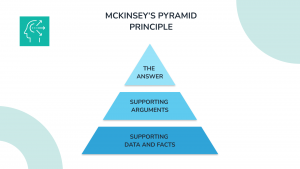
Include key takeaways:
- Opportunity – what happens in the market that makes it an excellent time to start your company?
- Target Market – who are you trying to serve?
- Challenge – what is the challenge specifically in your company’s communication?
- Value Proposition – what distinguishes you from other similar services?
- Mission – why does your company exist?
- Positioning – how do your customers think about the marketplace?
After that, encapsulate those key takeaways in the core messages of the strategic plan presentation:
1) Big Idea
A big idea functions as an organizational “totem pole” around which behavior, strategy, communications, and actions are aligned.
2) Unified Value Proposition
What is the overarching value proposition that is true for all customers?
3) Story/Pitch
What is the basic story about your solution in the larger context? It is the moment when you pull everything together: you’ve collected ideas, the company’s mission, the big idea, so it’s high time to tell your story.
Long story short, if you want your slides to evoke the WOW effect, add some drama and follow the next pattern:
✓ Current state of the world. ✓ Where are you heading? ✓ The problem. ✓ The solution.
And what better way to design strategy presentation than by hiring a professional presentation design agency ? This way, you will not only get a top-notch design for your strategic plan ppt presentation but also ensure it effectively communicates your ideas.
Strategy presentation structure
Each strategy plan presentation is unique and requires strategy slides PowerPoint explicitly tailored to the strategy and the brand identity. However, you can use the following basic structure as a guide:
Slide #1: The task
The first slide you give should always be carefully thought out and professionally designed. Explain why you’re presenting and describe the purpose or business problem that inspired the strategy. A diagram or an image to visually illustrate your points is a fantastic method to do this. Then, while you speak, build on the material to ensure that your audience is genuinely listening and not just scanning the text of your slide.
Slide #2: Insights
The insights slide is where you summarize the findings of your market research. Make sure it includes the specific data or trends you discovered during the market analysis stage. If you don’t include this information on the slide, you should have it ready in the presentation’s appendix in case there are any questions.
Slide #3: Guiding principles
This is one of the slides where you present your strategy. Therefore, it must be as convincing as possible. Take the time to select proper wording and polish content to perfection, as your mission statement should be clear, concise, and written in plain English. Pay attention to how you design your presentation as well: don’t clutter the slide with too much information, and keep the focus on the critical data.
Slide #4: Visual model
Your strategy revolves around solving a specific problem and demonstrating how this might work. The best way to explain your approach is through using a visual model (for example, a diagram or a flywheel), which can not only help you explain all the steps and actions that need to be taken in the most understandable way but also show how they can interact to achieve your goal.
Here’s a good flywheel template to visualize your data:
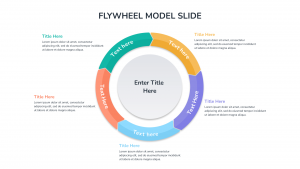
Slide #5: Tactics
You may need more than one slide to include all of the tactics you have planned to attain your goals. Explain all the steps in great detail while remaining clear and to the point. Be ready to answer the audience’s questions as they frequently arise during this section of strategy PowerPoint presentations.
Slide #6: Timeline
Timelines are crucial during a strategy plan ppt. Therefore, include the duration of each strategy phase and milestones you intend to attain by particular dates. Try to be as realistic about your strategy and desired outcomes as possible.
Slide #7: Closing slide
As with any presentation, you should pay special attention to the last slide of your strategy ppt as it is the last thing your audience sees and hears from you. Briefly summarize the most relevant points and consider including a meaningful quote that represents your inspiration or concluding with a list of the steps that need to be taken. Whatever you choose, make it clear that you are optimistic about your strategy and the company’s future.
Now that you know the basic structure of this type of presentation, let’s find out how to present a strategy in the most effective way.
5 tips on how to present a strategic plan on a presentation
Follow the recommendations below to make sure you’ll give your strategy presentation at your best:
Even though it sounds like a no-brainer, how many people do you know who just show up and deliver an awesome presentation? The way you give your presentation will influence the outcome, so dedicate enough time to polishing slides and practicing your presenting skills.
2. Begin with the ending in mind
What are the goals of your presentation? What do you want your audience to feel when you’re done? What do you want them to do when you’re done? All this requires you to explain the information presented to make your presentation memorable. For example, if you have numbers, do not just show them in a chart but tell WHY they matter.
3. Be clear and concise
Stakeholders are busy people, so don’t ramble. To avoid being cut off, prepare by reading, saying it aloud, and rehearsing your content beforehand. Make sure your speech is logical and juxtaposed with your slides.
4. Tell stories
The majority of people grow on stories. They like good stories and understand information based on examples better. Stories are just data with a soul, so make sure to bring yours to life. Personalize your data and connect to the audience with a good story.
5. Don’t read — talk
Make sure you are NOT talking through a slide by reading bullets. Instead, talk to the slide and your audience. Your PowerPoint is not your teleprompter. The presentation is not for you but for your audience.
Last but not least, to make certain that your presentation is professional, organized, and well-received by the stakeholders, contact the pitch deck design agency and focus on the speech part. This investment is worth a good night’s sleep and positive results.
#ezw_tco-2 .ez-toc-widget-container ul.ez-toc-list li.active::before { background-color: #ededed; } Table of contents
- Presenting techniques
- 50 tips on how to improve PowerPoint presentations in 2022-2023 [Updated]
- Keynote VS PowerPoint
- Types of presentations
- Present financial information visually in PowerPoint to drive results

Give a project plan presentation (expert senior-level tips)

How to create a business plan presentation?

30 60 90 day plan: a blueprint for professional growth
- Data, AI, & Machine Learning
- Managing Technology
- Social Responsibility
- Workplace, Teams, & Culture
- AI & Machine Learning
- Diversity & Inclusion
- Big ideas Research Projects
- Artificial Intelligence and Business Strategy
- Responsible AI
- Future of the Workforce
- Future of Leadership
- All Research Projects
- AI in Action
- Most Popular
- The Truth Behind the Nursing Crisis
- Work/23: The Big Shift
- Coaching for the Future-Forward Leader
- Measuring Culture

The spring 2024 issue’s special report looks at how to take advantage of market opportunities in the digital space, and provides advice on building culture and friendships at work; maximizing the benefits of LLMs, corporate venture capital initiatives, and innovation contests; and scaling automation and digital health platform.
- Past Issues
- Upcoming Events
- Video Archive
- Me, Myself, and AI
- Three Big Points

How to Create Slides That Suit Your Superiors: 11 Tips
When you’re pitching ideas or budgets to execs in your organization, you need to deliver slides that fit those particular people just right. This checklist identifies the key considerations.

- Workplace, Teams, & Culture
- Leadership Skills

Carolyn Geason-Beissel/MIT SMR | Getty Images
I recently interviewed 20 of my customers, all in senior roles at Fortune 100 companies, and asked them their biggest pain point in presenting to higher-ups and even colleagues. What I heard consistently was that it can feel like Goldilocks bouncing from one option to the next, testing to figure out what’s “just right.” Does the audience want deep reports? Sparse slides? Something in between? Like … what?
Teams often come to presentation meetings with vast amounts of backup content just in case an exec wants to take a deep dive on any given point. There’s often a struggle to anticipate every direction attendees might want to go. It’s frustrating, and it’s not efficient.
Get Updates on Transformative Leadership
Evidence-based resources that can help you lead your team more effectively, delivered to your inbox monthly.
Please enter a valid email address
Thank you for signing up
Privacy Policy
There are many ways to build slides. I’m not just talking about crafting them well versus poorly. I’m talking about all of the important decisions regarding how to organize them, how much text to use, when to lean into a chart, the best ways to use bullets and color, and whether to include an appendix with additional information. Before you make your next proposal or request of the executive team, use this list of 11 tips for your next set of slides as a guide.
Four Things You Must Have in Every Exec’s Slides
Before we drill down into the harder aspects, the ones where your executives’ tastes may vary widely, let’s quickly cover four aspects that you can consider the building blocks — the basics you should never proceed without.
Start with an executive summary. Begin the slide deck with a tight executive summary that follows a three-act structure. First, start with stating the current realities. Second, clearly state the problem or opportunity your idea addresses and its potential impact. Third, explain how your recommendation solves the problem or exploits the opportunity and the next steps you’re proposing.
Have a logical organization. The arc of the deck — the package from beginning to end — should make sense. If your audience reads only the headline of every slide, the order should be coherent and make most of the case for you. The content below each slide’s headline must support the statement made in the title. Remove everything that doesn’t support your point; as writers will tell you, you sometimes need to “kill your darlings” when you’re editing.
Begin the slide deck with a tight executive summary that follows a three-act structure.
Make it skimmable. Help your audience to quickly grasp the point without getting bogged down in details. Create a clear visual hierarchy. Guide the reader’s eye through the content: Use bold headings, bullet points, and numbered lists to break down information into digestible pieces. Highlight key takeaways or conclusions in a different color or font size to draw attention to these critical points.
Focus on concise insights. Succinct statements with clear insights are everyone’s jam. Every slide should serve a purpose and contribute directly to the decision-making process. Distill complex information. Don’t use 100 words when 20 words will nail it. If you’re having difficulty trimming, consider using company-approved AI tools to help you take out the fluff.
Five Preferences to Confirm With the Person You Want to Reach
Now we’ll delve into what your particular audience does and does not want. If you haven’t yet, start by asking the person you’re presenting to what they generally prefer. They probably know themselves well but have not been asked to articulate how they like to receive information.
Ask how dense is too dense. Some executives prefer detailed slides with comprehensive data. Others favor a more high-level approach. You’re weighing how to balance informative content with readability, ensuring that slides are not overloaded yet are sufficiently detailed to support decision-making.
Confirm the delivery format and timing. Some execs like information presented to them. Others prefer a pre-read of the material followed by a discussion. I always recommend our tool Slidedocs (I’ve written a free e-book on them), which are visual documents using both words and images. The templates help presenters organize their thoughts into a document for a pre-read or a read-along. They are designed to be skimmable and able to travel through your organization without the help of a presenter.
I’m a huge fan of pre-reads and prefer to use my time in meetings to ask questions and build alignment. If your audience didn’t review your material in advance, ask at the top of the meeting whether they would like you to present it or would prefer to read through it and then discuss it.
Find out how much data visualization they prefer. Charts, graphs, photos, and illustrations often communicate complex data more clearly than words alone. When execs can see what you’re saying, they often can better understand the impact of your idea. Does the exec want to understand exact numbers? Bar charts allow them to move their eyes across a series of specifics. Does the exec want to know the shape of a trend over time? Line charts can show the pattern. (See “Classic Charts Communicate Data Quickly.”) Some prefer charts with annotations that draw attention to what you think is the most important point. Others want to make their own conclusions from the data.
One of my clients, the CEO of a massive commercial real estate company, doesn’t want anything visualized. He prefers numbers, only in a table, and only in two colors — black and red. You might think this is archaic. But the fact that he’s clear to his teams about what he wants takes all the mystery out of how to communicate with him.
When the stakes are high, have a conceptual thinker help with diagrams and concepts. If you don’t have one on your team, and when it’s high stakes, find an internal designer to help you or hire one. You can’t afford to have the baby (your idea) thrown out with the bathwater (terrible slides).
Identify which details need spelling out. How well do the people you’re presenting to know the landscape and function of the company and products you’re talking about? For example, if your engineering team threw a slide into a deck about an issue that requires executive approval, do the execs all speak geek? Or do you need to explain the technology so that they will really understand the ask? Either eliminate internal jargon and acronyms or unpack those bits, especially if your proposal deeply involves expertise outside of the executives’ domain.
Ask whether appendices will be useful. When you’re organizing a presentation, you often troll data, read through complicated reports, and even hire external experts to figure out what’s best for the company. Do your execs want access to that supporting data? You can add a document to the end of the presentation as an appendix to show all of the data and source material. This allows the main content of the slides to remain focused and accessible while still providing comprehensive background information for those who want more.
Two Tips to Improve Your Presentation Skills
Getting materials in place is the biggest step. They will be your best tools for selling your ideas. But there are two extra areas to pay attention to as a presenter: how you handle questions and how you use every experience to improve.
Anticipate questions, and practice your answers. Before you have your meeting, gather a small team to challenge every point you make. Invite colleagues you trust to role-play as “a rapidly inquisitive exec” or “the doubting naysayer exec” so you are prepared to present your idea well. They’re gonna grill you, and practicing will help you remain unruffled when it happens.
Related Articles
Ask for feedback after the presentation. Establish a feedback loop with those you presented to. Ask what worked well and how you can improve. If attendees don’t have the time, find people who have had their ideas funded and talk to them about what they did that worked. Advice and some perspective will help you nail your performance even better next time.
Empathetically understanding your audience members and how they process information, whether it’s executives or peers, sets up your ideas for success. Clarity creates efficiency. When a presentation fits just right, you’ve given your great thinking the best chance of moving through your organization and having maximum impact.
About the Author
Nancy Duarte is CEO of Duarte Inc. , a communication company in the Silicon Valley. She’s the author of six books, including DataStory: Explain Data and Inspire Action Through Story (Ideapress Publishing, 2019).
More Like This
Add a comment cancel reply.
You must sign in to post a comment. First time here? Sign up for a free account : Comment on articles and get access to many more articles.
Get my FREE 17 minute Cold Calling Video Course
Live webinar: how to double your sales this year june 8, 2023 2:00:00 pm edt.
- The Sales Environment
- Sales is broken
- Modern sales
- Sales Resources
- Live Training Events

Upcoming training events & workshops

Online Training Platform
Sales accelerator.

#1 Resource
Revenue growth blueprint.
- Sales Accelerator Cohort 2024
- Sales Accelerator for individual reps
- Sales Accelerator for Sales Managers
- Hire Anthony to Speak
- WHY ANTHONY
LIVE TRAINING EVENTS
Upcoming virtual training events & in-person workshops, improve your win rates.

Keynotes & Workshops
Hire anthony to speak @ your event.
- Latest from The Sales Blog
How to Conduct an Effective Sales Strategy Presentation

As a sales professional , you’re used to selling to customers, but selling to stakeholders in your own organization is a different story. When you conduct a sales strategy presentation, that’s exactly what you’re doing: Demonstrating what you expect your team to accomplish to benefit the rest of the organization.
Your sales strategy is written. You’ve got all your numbers in order. Now, all that’s left is to present that strategy to your leadership team. 77% of people have a fear of public speaking, but that’s never applied to you… until now. Conducting a sales strategy presentation can be a lot of pressure.
I’ll give you my top tips for conducting a sales strategy presentation that is guaranteed to align your organization and excite the other stakeholders in your business.

What Is a Sales Strategy Presentation?
Before we provide the steps to conducting an effective sales strategy presentation, let’s first outline what a sales strategy presentation looks like.
A sales strategy presentation is your opportunity to ensure your sales goals and strategies are aligned with the goals and strategies of the other stakeholders in your organization. You will use this time to outline opportunities you see for the business to win new customers, as well as outline your plans to structure, train, and develop your sales team.
RELATED READ: How Long Does It Take to Develop a Modern Sales Force
It is my experience that sales leaders don’t spend enough time or energy teaching, training, and indoctrinating their sales force in their strategy—if they have one at all. This is one of the reasons that sales managers find themselves continually telling certain salespeople they are not allowed to match their competitor’s pricing or offering some concession that would break the strategy.
There are three groups that should be included in a sales strategy presentation. First, your senior sales leaders should be included in the strategy and the presentation. Second, your marketing team should also participate, as it will be important to acquire their help with things like market research and positioning, as well as the content the sales force will need. Third, and finally, the sales force needs to understand what their strategy requires of them.
Your strategy is a tool to create alignment within your sales force and your organization. It provides a structure that keeps everyone on the same page and helps you reach revenue growth goals. It’s a mistake not to use it for this purpose.
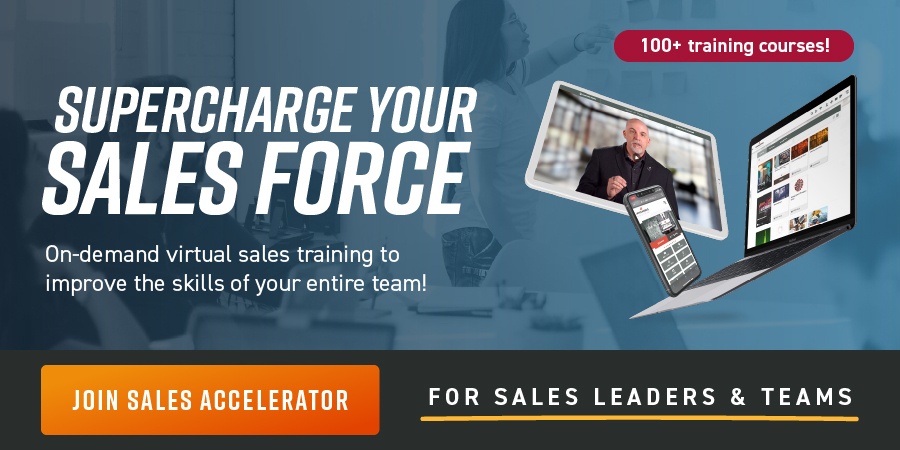
Start With Goals and KPIs
Your first step in conducting an effective sales strategy presentation is to nail down goals and KPIs . In your presentation, discuss performance over the past period. In a modern sales approach, we tend to spend a lot of time working on helping our clients answer, “why should I change now?” In this case, you are going to ask and answer this question yourself.
When you introduce your strategy or an update, data around your past performance helps to make the case for change, something John Kotter of Harvard describes as “a burning platform.” By answering “why change” first and enlightening your audience with the data that proves you not only capture their attention but also provide a justification for what comes next.
Establish goals your team will be shooting for over the next period. Even if you have to make a conservative estimate of the better results you are going to create in the first quarter you use your strategy, start with the goals and the KPIs you will be tracking.

Outline Your Market Strategy
What markets will you be targeting? Sometimes it makes sense to target a single vertical, but in many more cases, your strategy should be targeted to address the needs of customers in multiple markets, increasing the number of customers that will benefit from what you sell and how you deliver customer value.
When it is possible to identify the companies that spend the most in your category, putting forth the time and effort to pursue them will create greater net new revenue, speeding your results, provided you get your strategy right and your team properly trained and enabled.
How did you establish this? You want to help your leadership team, your marketing team, and your sales force to understand why you made the decisions as to who and why you have chosen these targets and how your strategy is going to improve results.
Present data to support your strategy. Presenting the data that is driving your decisions not only helps you inform your team about your choices, but a conversation with your teams can identify other considerations and modifications that make your plan even more powerful.

Describe Training & Development Efforts
Plan for team training and development to hit key metrics. Most sales leaders don’t recognize the connection between their sales force’s effectiveness and their ability to execute the company’s strategy. Without being trained to execute the strategy, you risk failing to execute the strategy well enough for it to produce the results you need. This is critical if your strategy requires a consultative approach, as most salespeople have never been taught to use a modern sales approach.
Our training and development on the Sales Accelerator Platform provides the curriculum to train salespeople to execute your strategy and provide them with a culture shift, one that reinforces your strategy and one with proven results.
Discuss Budgetary Needs
Lastly, a strategy shift comes with expenses. Some of these expenses include training and development, marketing assets and tools, and in some cases, hiring a number of new salespeople who have a track record in executing your chosen strategy. Ensure you’re making your budgetary needs known during your presentation.

An Effective Sales Strategy Presentation is Only the Beginning
Conducting an effective sales strategy presentation is a vital step to aligning your team with the rest of your organization, and securing the budget you need to move your team forward in the next period. Following the steps outlined here, you should have all the tools you need to conduct a sales strategy presentation that everyone can agree upon.
But the sales strategy presentation is just the beginning! To get the results you need and hit those metrics you’ve outlined, you’ll need some help. Our Sales Accelerator can help you level up your team’s skills, giving them the ability to crush the goals in your sales strategy. Check out Sales Accelerator today!
Written and edited by human brains and human hands.

How to Lead: The Leadership E-Book
As leaders, we're faced with decisions everyday—not all of which are easy to make. Learn how to make those tough decisions, hold yourself and your team accountable, and build a legacy with How to Lead: The Leadership E-Book.

Are You Ready To Solve Your Sales Challenges?

Hi, I’m Anthony. I help sales teams make the changes needed to create more opportunities & crush their sales targets. What we’re doing right now is working , even in this challenging economy. Would you like some help?

Join my Weekly Newsletter for Sales Tips
- OPEN COURSES
- All Open Courses
- SELECT FROM
- Sales Fundamentals
- Advanced Selling Skills Training
- Account Management Training
- Telesales Training
- Essential Selling Skills Training
- Sales Management Training
- IN-HOUSE & CUSTOMISED
- In-House Training
- Sales Programmes
- DIGITAL SOLUTIONS
- Online Sales Training
- ASSESSMENT TYPES
- Sales Testing – FREE
- Negotiation Skills Testing – FREE
- Sales Personality Test
- Sales Competency Assessment
- CHOOSE FROM
- Sales Leader
- Sales Executive
- Sales Administrator
- FREE RESOURCES
- Sales Techniques – Videos
- Special Reports
- Clients & Case Studies
- Download Our Brochure
Home » MTD Sales Blog » 13 Steps For Creating Your Sales Strategy Presentation
13 Steps For Creating Your Sales Strategy Presentation

But where do you start when it comes to putting one together?
We’ve got 13 useful steps to help you create an effective Sales Strategy Presentation that your stakeholders will love! From start to finish, we’ll cover everything you need to make it a huge success. Let’s get started!
- What Is a Sales Strategy?
- What Is a Sales Strategy Presentation?
- How to Create Your Sales Strategy Presentation
- Effective Sales Strategy Presentation Template
- Wrapping Up

A Sales Strategy is a plan which aims to maximise sales whilst coordinating the plan across your whole sales team and aligning it with the corporate strategy.
Research giant Gartner defines Sales Strategy as “an organisation’s detailed plan to drive sales performance, innovation and growth by better penetrating existing markets and growing share of current customer wallet.”
This definition downplays the corporate alignment aspect and focuses on sales performance. However, a Sales Strategy does not merely consist only of delineating your sales approach.
In brief, a well-written Sales Strategy can be said to have three main aims:
- To ensure all reps are working to the same playbook and adopting a uniform approach
- To ensure that sales methods, messaging, and media reinforce corporate priorities
- To maximise sales revenue, within given targets and KPIs
The above list is not ordered in terms of priority—all three aims contribute vitally to your Sales Strategy.
When we’re talking about a presentation, it’s important to distinguish this from the pitch you’ll give to your clients. A Sales Strategy Presentation is where you obtain corporate buy-in for your sales approach, making sure that messaging, pricing, product specs, sales media and other details of your campaigns are clarified and agreed across the board.
In this presentation you’ll describe your target market, competitors, sales techniques , and the composition of your sales team, amongst other information. The aim is to secure support for your strategy, which may include budget approval. It’s important to include enough detail to convey the main information, without overburdening your audience.
Below, we’ll look at how best to go about preparing your presentation, alongside some tips for maximising audience attention and approval. If you can nail this presentation, you’ll be off to a flying start with your strategy, so it’s worth putting the hours in to get it right.
The most important thing to get right is your structure. This should be logical and narrative-driven, leading the audience from big picture to fine detail. It should be compelling and as brief as possible, without short-changing your audience. Remember that you’ll be asked plenty of questions when your presentation is complete!
1. Start with an Overview of Your Company
Begin by outlining the current state of play within the company. If you are an agency selling your strategy to a company, here’s your opportunity to demonstrate a rounded understanding of the company and its priorities, as well as giving a summary of your agency, and what it does.
If you are heading up an in-house sales team, you have the chance to maximise corporate buy-in, and ensure your strategy is fully supported with the necessary resources.
Don’t go into exhaustive detail – offer the sort of brief “executive summary” you find at the front of annual reports. Do use bullet points and figures where these are impressive enough to support your case. Highlight the opportunity your Sales Strategy will address, whether it’s a gap in the market, the chance to cross/up-sell a new product, or some other benefit you’ll bring.
2. Touch on Your Target Market
Here’s where you identify who your ideal customers or clients will be, and really hit home that you understand your customer.
You can use buyer personas , which may include graphics depicting “typical” customers, to help your audience visualise who you’ll be selling to. In terms of aggregate markets, you can include Venn diagrams or other graphic means to delineate core customers and subsidiary consumers.
For instance, if you’re selling an app for video editing, your core customers may be corporate content producers, but your subsidiary audience may be far wider, touching upon anyone who regularly uploads content to YouTube or other social media platforms.
You’ll need to describe how you’ll approach all your significant markets elsewhere in your presentation (see step 5).

3. Discuss the Value of Your Proposition
USP or Value Proposition (VP) is a concise statement of what makes your product stand out in your chosen marketplace. It’s a vital concept for sales reps to grasp because it’s the main reason why a consumer would choose your product over a rival’s. It’s important that all stakeholders buy into the value proposition because it’s a key factor in building brand identity.
For instance, some footwear brands stress comfort as their USP, while others highlight value, durability, style, or exclusivity. Your VP could also be a combination of factors, i.e. going back to the app for video editing example, “we offer the most accessible, best value for money and most fully featured video editing app on the market”.
Key to your VP is describing the “problem” a customer might have and how your product is the perfect solution to that problem. How will your customers uniquely benefit from the product you’ll be selling?
You can use comparisons with rival products, and data taken from market research, showing what consumers want, and how your product addresses those needs. Literal quotes taken from review sites can be helpful, revealing how real customers feel about their purchases.
The main takeaway is that your sales team are enthusiastic about the value they are offering customers, and that they understand how to characterise the benefits and features of the product.
4. Consider Any Competitors
It’s essential at this stage to factor in your competitors. Unless you are first to market or are offering a very niche product, the chances are you have a host of rivals eager to bite off chunks of your customer base. Here you need to emphasise that your sales team have the answers to the question “why us?”
Differentiation is key! What solutions does your product offer that rivals cannot? It’s important not to underestimate the competition and respect the successes that other players in the sector have scored. Much can be learned by studying the achievements of legacy brands, while offering something that builds upon previous offerings.
It can be a good idea to tabulate your top three or five competitors and show how their success provides an opportunity, rather than a threat. Remember that competitors should be understood in the broader context and can help you turn your weaknesses into strengths.
For instance, Netflix hasn’t only got to worry about Amazon Prime TV, Disney Plus and other streaming services. It must compete with cinema, social media and podcasts too. These are all popular draws upon customers’ leisure time.
5. Outline Your Marketing Strategy
Now you can summarise how your product will be marketed. Will conventional advertising be used? Will social media play a significant role? Is this a B2B campaign or will the product appeal to individual customers? Will buyers be targeted at work, or at home?
Perhaps you have partners working on marketing campaigns. If so, introduce them, and their best work to date. Provide examples of finished campaign materials if you have them or works in progress if that’s all you have at this stage. This is a good opportunity to use dramatic visuals or video, rather than text or graphs, which can become boring if overused.
Your marketing strategy should include the following five elements:
- The target audience for the campaign
- The goals or objectives
- How your brand will stand out against competitors
- What content has or will be created
- Any KPIs that have been agreed
You can finish by briefly describing how marketing and sales departments will cooperate and coordinate their efforts.
6. Go Over Your Sales Process
Here you can drill down into the specifics of the sales process. What does your sales funnel look like? Where are you getting your leads and how are you qualifying them? Will cold calling or email drip campaigns be a major part of the process? Will you have a presence at any trade shows or events?
Do you have scripts that you can share to offer an example of a typical sales contact? Provide concrete examples to help your presentation feel solid. If you have incentives planned for your sales team, or KPIs you expect them to achieve, then outline them here too. You can break down your sales activities into:
- Prospecting (including lead sources)
- Lead segmentation and qualification
- Research processes – market research, customer surveys
- The sales pitch – a typical call or contact
- How your team will handle sales objections
- The process for closing .
Once you have outlined what you’ll do to make sales, it’s time to explore who will do what.
7. Review the Current Sales Team Structure And Roles
Begin with an organisational diagram of your sales team, so that your audience will get a clear picture of command structure. Outline the responsibilities of each role, lines of reporting and (if relevant) base salaries.
If you are creating a sub-team for this project, then show the diagram for that sub-team. There’s no need to reinvent the wheel with an organisational chart since everyone understands the traditional flowchart model. Use that, to save valuable time.
Explain any unfamiliar roles or unexpected team members. Perhaps you have an in-house social media researcher, or a CRM specialist . Make sure you highlight and explain anything unexpected. You can also identify roles that are not filled yet, which will help when it comes to steps 10 and 11.
8. Summarise Any Sales Materials Used
If you have leaflets, landing pages, product listings, demonstration videos or anything else that will be key to the sales process, then here is a suitable time to hand out samples or give demonstrations. If you’re offering a free demo version of a piece of software, you can quickly run through its features and how you plan to convert free users to paid subscribers.
Remember that if you provide handouts, your audience will lose eye contact with you while they pore over them, so use this option sparingly. You can always provide supplementary handouts or follow-up emails, after your presentation is over.
9. Talk Through Goals, Sales Metrics and KPIs
All goals and objectives expressed should conform to the SMART principle, being specific, measurable, achievable, relevant , and time-based.
Try to be specific with sales targets, without promising more than you can reasonably deliver!
You can have nested targets—fair, good, and excellent anticipated results—while stressing that you’ll always be aiming for the latter. You can also express goals in terms of short, medium, and long-term. This is especially relevant when you’re launching a brand-new product, or entering a new market, where it would be unrealistic to achieve full market penetration immediately.
It’s very important to obtain buy-in on your goals and targets, so that there’s transparency across the organisation, and you can be held accountable if you fail to deliver. That’s the downside of getting specific with KPIs, but it’s also a great motivator for sales teams. On the plus side, you can also mention any incentive or bonus structure you’ll be offering your sales team for achieving ambitious goals.
10. Explore Training and Development Requirements
If you know you’ll need to train up staff to understand a new product, software system, or working process, then it’s valuable to admit this upfront. Training needs affect the bottom line, as well as your process timeline. You have the opportunity here to demonstrate that you’ve thought through all human resource requirements and researched training opportunities. You may already have Sales Training Providers you’ll partner with (mention them now) or if you’re still looking why not check out our Essential Selling Skills Training or Telesales Training Course.
Spending time on this aspect of your Sales Strategy will also build stakeholder confidence. They’ll know you aren’t throwing your reps in at the deep end. Instead you are preparing them properly for success.
11. Consider Any Budgeting Needs
With resources in mind (IT, human resources, content creation, research costs and other expenses) outline what you expect your operating sales budget to be. There is no point in understating your anticipated costs, since overruns may occur, and senior management will often try to make cost savings. It pays to build in a little wriggle room for negotiation.
Don’t blind or bore your audience with spreadsheets; just give the headline figures. Highlight any areas of expenditure that are loosely estimated, or unclear. Remember to allow for hiring costs for any unfilled sales team roles you described in step 7 (see above), and for staff training.
Remember also to include cash flow, as well as overall expenditure. How much money will you need and at what milestones? Sometimes success can be more expensive than failure; for instance, when it necessitates a sudden recruitment drive to expand your sales team. It’s vital for stakeholders to appreciate key dates when funding must be made available.
12. End With Next Steps And Future Action Plans
If you’ve prepared a simplified GANTT chart, you can show where in the project timeline you currently sit. Explain what your next actions will be, and what the future holds. Here you can build further confidence by demonstrating that you’ve thought everything through.
Remember to build in a little more time than you think you’ll need for more flexible stages like research, training, and lead prospecting. Make sure you highlight any immovable deadlines, like sales events or product launches, and how you’ll ensure you’re prepared for them.
You should also be building excitement and enthusiasm here, so don’t make it too dry. This is a thrilling time—you’re about to hit the go button on a brand-new sales campaign. Get your audience to feel your enthusiasm and you’re halfway to achieving buy-in.
13. Don’t Forget To Use Engaging Visuals Throughout!
The cliché is true – a picture is worth a thousand words. Sometimes a short video or meme can make a more dramatic point than yet another set of bullet points, facts, or figures.
There’s a popular rule of thumb with PowerPoint slides, called the 7 x 7 principle. This states that no single slide should contain more than seven lines of text, and each line should contain no more than seven words. How many presentations have you witnessed that fail to pass that test? Too many, most likely!
Avoid this issue by preferring visual content over words. After all, you are there to deliver the verbal component of the presentation. You can do this so much more effectively with your communication and interpersonal skills. You already know this — you’re a salesperson!
Finally, make sure you leave time for questions (and prepare some answers to likely ones in advance). Thank your audience for their time… and relax!
Now you know how to create your presentation, it’s time to have a go at making it! Here’s a PowerPoint template you can download to kick you off.
The deck includes 13 slides covering all the sections we’ve touched on. Just customise the template by adding your own branding font and colours – and don’t forget to add some of those engaging visuals we’ve spoken about!
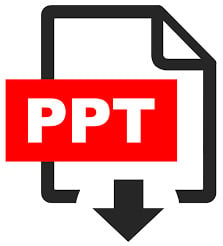
Perhaps it’s worth leaving you with a simple thought – you can enjoy this moment! After all, it’s the culmination of a complex sales planning process, and now you get to share your vision with everyone who matters. That opportunity doesn’t come around very often. So, take a moment to congratulate yourself on your hard work, and have fun!
Finally, here are some parting thoughts on presentations, from writers and speakers who’ve been there:
“They may forget what you said, but they will never forget how you made them feel.” –Carl W. Buechner, politician and church leader.
“The first 30 seconds and the last 30 seconds have the most impact in a presentation.” –Patricia Fripp, Sales presentation expert and speech coach.
“You are not being judged, the value of what you are bringing to the audience is being judged.” –Seth Godin, dotcom executive and bestselling author.
Hopefully, this article has reminded you of some principles you already understand and has given you the inspiration to really smash your Sales Strategy Presentation!
If you need any extra sales support for you or your team, please contact us for further information on our Sales Management Training and Account Management Training solutions, also take a look at our popular portfolio of Sales Training Courses .
Happy Selling!

Sean McPheat Managing Director MTD Sales Training
- General Sales Skills
Updated on: 13 June, 2023
Would your connections like this too? Please share.
Related Articles
Popular Courses
Telesales Training Selling Skills Training Sales Management Training Account Management Training
MTD Sales Training 5 Orchard Court, Coventry CV3 2TQ, UK 0333 320 2882
MTD Sales Training is a Sales Training Company drawing on years of experience in the sales performance industry since 2001.
Privacy & Other Important Policies Sitemap
- PRO Courses Guides New Tech Help Pro Expert Videos About wikiHow Pro Upgrade Sign In
- EDIT Edit this Article
- EXPLORE Tech Help Pro About Us Random Article Quizzes Request a New Article Community Dashboard This Or That Game Popular Categories Arts and Entertainment Artwork Books Movies Computers and Electronics Computers Phone Skills Technology Hacks Health Men's Health Mental Health Women's Health Relationships Dating Love Relationship Issues Hobbies and Crafts Crafts Drawing Games Education & Communication Communication Skills Personal Development Studying Personal Care and Style Fashion Hair Care Personal Hygiene Youth Personal Care School Stuff Dating All Categories Arts and Entertainment Finance and Business Home and Garden Relationship Quizzes Cars & Other Vehicles Food and Entertaining Personal Care and Style Sports and Fitness Computers and Electronics Health Pets and Animals Travel Education & Communication Hobbies and Crafts Philosophy and Religion Work World Family Life Holidays and Traditions Relationships Youth
- Browse Articles
- Learn Something New
- Quizzes Hot
- This Or That Game New
- Train Your Brain
- Explore More
- Support wikiHow
- About wikiHow
- Log in / Sign up
- Education and Communications
- Presentations
How to Give a Presentation
Last Updated: October 4, 2023 Fact Checked
This article was co-authored by Patrick Muñoz . Patrick is an internationally recognized Voice & Speech Coach, focusing on public speaking, vocal power, accent and dialects, accent reduction, voiceover, acting and speech therapy. He has worked with clients such as Penelope Cruz, Eva Longoria, and Roselyn Sanchez. He was voted LA's Favorite Voice and Dialect Coach by BACKSTAGE, is the voice and speech coach for Disney and Turner Classic Movies, and is a member of Voice and Speech Trainers Association. There are 10 references cited in this article, which can be found at the bottom of the page. This article has been fact-checked, ensuring the accuracy of any cited facts and confirming the authority of its sources. This article has been viewed 526,078 times.
Giving a presentation terrifies most of us, especially when talking before a crowd of people about an unfamiliar topic. Never fear! There are ways to make a good presentation. The more presentations you do, the easier they will become!
Preparing For the Presentation

- It's best to have 1 main thesis statement or overarching theme and 3 main points that back-up or flesh-out your main theme. Any more than that and your audience is going to start losing interest. This means that any facts and information that are a part of your presentation should back up these 3 main points and overarching theme.
- For example: If you're giving a presentation about 17th century alchemy, bringing up the history of alchemy is fine (and probably necessary), but don't mire your audience in its history instead of focusing alchemy in the 17th century. Your 3 points could be something like "alchemy in public opinion," "famous 17th century alchemists," and "the legacy of 17th century alchemy."

- Pick your very best supporting facts, information, or quotes for your presentation. Don't bury your audience in information.

- Make sure you're using media to enhance your presentation and not to drown it out. The presentation is key. Anything else is just accessorizing.
- For example: to get back to 17th century alchemy, to back up your information about alchemy in the public opinion, you might want to show images from public pamphlets about the dangers of alchemy and see what people of the time period had to say about it and see what the more famous alchemists had to say about it.
- Also, you want to make sure that you pick a medium that you are comfortable in and thorough in knowledge. If you don't know a thing about PowerPoint, maybe consider writing your main points on a white board, or passing out handouts with your main points and evidence on them. [3] X Research source

- A good tip is to film yourself or audiotape of yourself giving your practice presentation so you can see what distracting verbal and physical tics you have, so that you can work on eliminating them before the presentation itself. (Verbs tics would be things like "um..." and "uh..." and using "like" inappropriately; physical tics are things like shifting your weight from foot to foot or messing with your hair.) To stop yourself from saying "um" or other unwanted tics, be aware you're doing it first, then speak more slowly and deliberately. Breathe deeply and feel free to pause and appreciate the silence. These will all help you to have mastery over your tics.
- Just remember that rehearsals usually run about 20% shorter than your actual presentation, so take that into account if you're running on a time limit.

- For example, if you aren't comfortable wearing heels, don't wear them just for the presentation. You'll be distracted by your discomfort and that will come across in the presentation. There are plenty of good shoe choices that have no or a low heel.
- Clean, nice slacks or a skirt and nice, button-down shirt in neutral colors are always good choices for presentation wear. You also don't particularly want your clothing choice to distract from the presentation, so perhaps avoid that brilliant hot pink shirt.
Giving the Presentation

- Before the presentation, clench and unclench your hands several times to deal with the adrenaline and then take 3 deep, slow breaths.
- Call up a smile, even if you feel like hurling. You can trick your brain into thinking that you're less anxious than you actually are and you'll also be able to hide your nervousness from your audience.

- Make eye contact with your audience. Don't stare at one particular person, but section up the room and make eye contact with someone in each section on a rotational basis.
- Have a big, welcoming smile on your face, with lots of energy, so you start out from a strong and engaging place.
- Ask questions of your audience and take questions during your presentation. This will make it more of a conversation and therefore more interesting.
- Tell an amusing anecdote to illustrate your point. From the above examples about 17th century alchemy, you could find an amusing alchemical anecdote from the time period, or you could talk about your own forays into alchemy.

- Move around, but make your movements deliberate. Don't nervously shift your feet (in fact, it's a good idea to imagine that your feet are nailed to the floor except for those times you deliberately choose to move).
- Use your vocal inflections to create a more dynamic presentation. Vary your voice as you're talking. Nobody ( ever ) wants to sit there and listen to someone drone on and on in dull monotone, no matter how interesting the material (think Professor Binns from Harry Potter; that's what you don't want).
- Try to create a balance between rehearsed and spontaneous. Spontaneous, on the spot, movement and asides can be great as long as you are really comfortable, otherwise they can sidetrack your presentation and make it rambling. Mess around with spontaneous and rehearsed when you're practicing and you'll get a feel for it.

- Quickly introduce your topic and don't assume that your audience is familiar with all the terms, especially if your topic is one that isn't widely known.
- Figuring out why you want (or have to) give this presentation will help you work with an overarching story/theme. Maybe you want to pass the class. Maybe you're convincing people to give you money or join you in a philanthropic endeavor or act for a social or political reason. Channel that desire into your presentation. You're answering the question of why they would want to pass you or why they would want to fund you. That's the story you're telling.

- Make use of pauses, and learn to be comfortable with silences. Silence can be a powerful presentation tool and gives you a chance to take a moment to recompose. By taking pauses, you can slow down your breathing and be more deliberate in your speech, avoiding speaking too quickly.
- Have water with you and take a sip when you feel you're going too fast.
- If you have a friend in the class or meeting, arrange with them beforehand that they will let you know with a signal whether you're talking too quickly. Look over their way occasionally and check your progress.
- If you find that you're running out of time and you haven't finished, simply drop or summarize your leftover material. Acknowledge the leftover material as something that can be discussed later or in the Q&A.

- Make it clear what the listeners now know and why it is important that they have this new information.
- Conclude with examples or stories about your main point and take home message. You might want a slide which summarizes your presentation. For example, you might conclude with a story about the nature of alchemy in the modern era (perhaps in a film) to show its malleable nature.
What Is The Best Way To Start a Presentation?
Community Q&A
- Have a short Q&A session at the end of each subtopic. Q&A sessions will improve audience engagement. It also acts as a welcome break for audience in case of long presentation. For this though, you will need to know the subject you choose well. Make sure you understand and have more than just the basic knowledge about the topic you choose. Thanks Helpful 1 Not Helpful 0
- Use pictures or visuals. Pictures and visuals show that you know what you're talking about, and it gives the audience a picture of what you're talking about. Thanks Helpful 0 Not Helpful 0
- Try to have a "leave behind" message, something that your audience can take away that reminds them about your presentation, like a flyer or a book, for example. Thanks Helpful 0 Not Helpful 0
Tips from our Readers
- Use pictures! A good way to use pictures is through PowerPoint. If you don't have PowerPoint, you can print the pictures onto a board (paper, card board, or larger paper).
- Don't be nervous. Practice and do just like you did in practice. If you are nervous, the audience will know.
- Try to do some hand jesters. Speak loud and clear. Make eye contact with them. Be confident.
- Let the audience have an opportunity to interact with you.

- Don't make your speech too long, unless it is really good, and you have to have done speeches for a long time to have them be that good and long. Stick to short and sweet. Thanks Helpful 49 Not Helpful 11
- Don't put off work to the last minute. Then your work will be most likely sloppy. If you do well under pressure, do your project a bit at a time and maybe it will get done. Or, try doing it all at the beginning, so then you have the whole rest of the time to play or check your assignment. Thanks Helpful 35 Not Helpful 16
- Jokes are usually not okay, especially in a professional setting. A light hearted comment is fine, but don't make it seem like a comedy show. Thanks Helpful 11 Not Helpful 3
- If you speak in a too fast/slow or monotone voice, people will not want to hear you! Aim for a conversation voice (but slightly louder) with natural pauses (commas and periods). Develop a tone depending on what you're talking about. It's more interesting and engaging to hear someone speak in a serious tone rather than a monotone when speaking about world hunger. Thanks Helpful 7 Not Helpful 2
- If you suffer from twitchy fingers, be mindful to move your hands during your presentation only when necessary, or the audience may notice and feel you are unprepared. Thanks Helpful 8 Not Helpful 3
You Might Also Like

- ↑ http://www.huffingtonpost.com/young-entrepreneur-council/13-tips-for-giving-a-kill_b_3728093.html
- ↑ https://www.niu.edu/presentations/prepare/index.shtml
- ↑ https://algonquincollege.libguides.com/studyskills/creating-presentations
- ↑ https://www.indeed.com/career-advice/career-development/how-to-prepare-the-presentation
- ↑ http://www.washington.edu/doit/TeamN/present_tips.html
- ↑ https://counseling.uiowa.edu/self-help/30-ways-to-manage-speaking-anxiety/
- ↑ https://www.hamilton.edu/academics/centers/oralcommunication/guides/how-to-engage-your-audience-and-keep-them-with-you
- ↑ http://hbr.org/2013/06/how-to-give-a-killer-presentation/ar/1
- ↑ https://www.linkedin.com/pulse/how-slow-down-your-speech-when-presenting-sharon-maree-jurd-cfe/
- ↑ https://www.indeed.com/career-advice/career-development/how-to-conclude-a-presentation
About This Article

Before you give a presentation, spend some time crafting what you will say. Most presentations should center on a thesis, or main idea, and contain about 3 supporting points. Cutting unnecessary content will ensure your presentation is impactful. Once your presentation is done, practice delivering it in front of a mirror or while recording yourself so you can identify and correct any issues. To calm your nerves before you present, try clenching your fists a few times and taking several deep breaths. For more advice about giving presentations, like whether to use visual aides, keep reading! Did this summary help you? Yes No
- Send fan mail to authors
Reader Success Stories
Nkosinathi Mathebula
Jun 14, 2017
Did this article help you?

Prashant Mahasagar Sangson
Aug 8, 2017
Dharmender Mangla
Apr 26, 2016
Hedika Amani
Jan 14, 2019
May 5, 2016

Featured Articles

Trending Articles

Watch Articles

- Terms of Use
- Privacy Policy
- Do Not Sell or Share My Info
- Not Selling Info
wikiHow Tech Help Pro:
Level up your tech skills and stay ahead of the curve
ORIGINAL RESEARCH article
The interactive effect between economic uncertainty and life history strategy on corrupt intentions: a life history theory approach.

- 1 Fudan University, Shanghai, Shanghai Municipality, China
- 2 Department of Psychology, Fudan University, Shanghai, China
The final, formatted version of the article will be published soon.
Select one of your emails
You have multiple emails registered with Frontiers:
Notify me on publication
Please enter your email address:
If you already have an account, please login
You don't have a Frontiers account ? You can register here
Why do some people show more corruption when facing uncertain environment?The present study aimed to give a plausible answer from an evolutionary perspective: this might be rooted in people's different life history strategies (slow vs. fast). The present study measured the participants' corrupt intentions by a hypothetical scenario and primed the feeling of economic environmental uncertainty by requiring the participants to read economic uncertainty (vs. neutral) materials. It is revealed that the participants with fast life history strategies had stronger corrupt intentions after reading materials about economic uncertainty than reading neutral materials. In addition, the desire for power mediated the interactive effect between life history strategy and economic uncertainty on corrupt intentions for fast life history strategists. This finding was discussed for its theoretical and practical implications from the perspective of life history theory.
Keywords: Economic uncertainty, life history strategy, Desire for power, corrupt intentions, evolutionary psychology perspective
Received: 25 Dec 2023; Accepted: 11 Apr 2024.
Copyright: © 2024 Sai and Zhu. This is an open-access article distributed under the terms of the Creative Commons Attribution License (CC BY) . The use, distribution or reproduction in other forums is permitted, provided the original author(s) or licensor are credited and that the original publication in this journal is cited, in accordance with accepted academic practice. No use, distribution or reproduction is permitted which does not comply with these terms.
* Correspondence: Lei Zhu, Department of Psychology, Fudan University, Shanghai, China
Disclaimer: All claims expressed in this article are solely those of the authors and do not necessarily represent those of their affiliated organizations, or those of the publisher, the editors and the reviewers. Any product that may be evaluated in this article or claim that may be made by its manufacturer is not guaranteed or endorsed by the publisher.
- SUGGESTED TOPICS
- The Magazine
- Newsletters
- Managing Yourself
- Managing Teams
- Work-life Balance
- The Big Idea
- Data & Visuals
- Reading Lists
- Case Selections
- HBR Learning
- Topic Feeds
- Account Settings
- Email Preferences
5 Tips for Giving a Persuasive Presentation
When you need to sell an idea at work or in a presentation, how do you do it? Five rhetorical devices can help — Aristotle identified them 2,000 years ago, and masters of persuasion still use them today: Ethos. Start your talk by establishing your credibility and character. Show your audience that you are committed […]
When you need to sell an idea at work or in a presentation, how do you do it? Five rhetorical devices can help — Aristotle identified them 2,000 years ago, and masters of persuasion still use them today:
Source: This tip is adapted from “The Art of Persuasion Hasn’t Changed in 2,000 Years,” by Carmine Gallo
Partner Center

IMAGES
VIDEO
COMMENTS
Highlight the Issue: Every story needs a conflict. In your strategy presentation, this is the issue or challenge at hand. Paint a vivid picture. Make them see what's going awry. But remember, no doom and gloom—just honest, relatable content. b. Showcase Your Solution: Now, for the hero of our story - your solution.
Here are a few tips for business professionals who want to move from being good speakers to great ones: be concise (the fewer words, the better); never use bullet points (photos and images paired ...
A strategy is much more than that. It's how you convince your audience that your plan is great so they'll buy-in to your approach. Think of the tactics as the "what" and the goal as the ...
When in doubt, adhere to the principle of simplicity, and aim for a clean and uncluttered layout with plenty of white space around text and images. Think phrases and bullets, not sentences. As an ...
Tip #1: Tell stories. Sharing an anecdote from your life can improve your credibility and increase your relatability. And when an audience relates to you, they're more likely to feel connected to who you are as a person and encouraged to give you their full attention, as they would want others to do the same.
Frame your story (figure out where to start and where to end). Plan your delivery (decide whether to memorize your speech word for word or develop bullet points and then rehearse it—over and ...
As a strategy consultant, you very quickly realize there are two important components of a compelling strategy presentation: The 'thinking'. This is the rigorous problem definition, analysis, synthesis, and insight that happens before you open up PowerPoint. Without this, even the most well-crafted strategy presentation lacks impact.
Strategic plan presentation. Strategy: A comprehensive overview of your organization's overarching strategy. Presentation: Delivering this strategy to stakeholders, often in the form of a roadmap. . 2. Marketing strategy presentation. Strategy: Focused on marketing goals and tactics.
Pay attention to the way the slide is designed, too - don't overload the slide; keep the focus on the key phrase. Slide #4: Visual model. Your strategy is based on solving a problem, and showing how this might work. It is a pathway to the future success of your company, based on data and experience.
Apply the 10-20-30 rule. Apply the 10-20-30 presentation rule and keep it short, sweet and impactful! Stick to ten slides, deliver your presentation within 20 minutes and use a 30-point font to ensure clarity and focus. Less is more, and your audience will thank you for it! 9. Implement the 5-5-5 rule. Simplicity is key.
The secret structure of great talks. From the "I have a dream" speech to Steve Jobs' iPhone launch, many great talks have a common structure that helps their message resonate with listeners. In this talk, presentation expert Nancy Duarte shares practical lessons on how to make a powerful call-to-action. 18:00.
Highlight the most critical objectives and strategies. 4. Business overview. Give an overview of your organization, its mission, and its current position in the market. ... In your strategy presentation, cover essential components such as your mission statement, vision statement, and a detailed strategic plan with clear, actionable goals and ...
Many people are nervous or fearful before giving a presentation. A bad memory of a past performance or insufficient self-confidence can contribute to fear and anxiety. Having a few go-to strategies like deep breathing, practicing your presentation, and grounding can help you transform that fear into extra energy to put into your stage presence.
Structure Your Presentation Like a Story. by. Nancy Duarte. October 31, 2012. PM Images/Getty Images. After studying hundreds of speeches, I've found that the most effective presenters use the ...
4Engage Audience. Engaging your audience is crucial for a successful executive presentation. Instead of merely presenting information, encourage participation and dialogue. Ask thought-provoking ...
This Strategy Presentation Template helps transform strategic ideas and thinking into actionable plans. With a clear template, you can present a strategy to your team to ensure that everyone is on the same page about where your business is heading. Visual learning is a great way to engage employees and get them on board with never-before-seen ...
Make sure that you are giving the right messages: body language to avoid includes crossed arms, hands held behind your back or in your pockets, and pacing the stage. Make your gestures open and confident, and move naturally around the stage, and among the audience too, if possible. 10. Relax, Breathe and Enjoy.
Slide #1: The task. The first slide you give should always be carefully thought out and professionally designed. Explain why you're presenting and describe the purpose or business problem that inspired the strategy. A diagram or an image to visually illustrate your points is a fantastic method to do this.
First, start with stating the current realities. Second, clearly state the problem or opportunity your idea addresses and its potential impact. Third, explain how your recommendation solves the problem or exploits the opportunity and the next steps you're proposing. Have a logical organization.
First, your senior sales leaders should be included in the strategy and the presentation. Second, your marketing team should also participate, as it will be important to acquire their help with things like market research and positioning, as well as the content the sales force will need. Third, and finally, the sales force needs to understand ...
2. Touch on Your Target Market. Here's where you identify who your ideal customers or clients will be, and really hit home that you understand your customer. You can use buyer personas, which may include graphics depicting "typical" customers, to help your audience visualise who you'll be selling to.
It's likely about a fear of public humiliation rather than of public speaking. Shift the spotlight from yourself to what you have to say. Reject the voice in your head trying to destroy your ...
Move around, but make your movements deliberate. Don't nervously shift your feet (in fact, it's a good idea to imagine that your feet are nailed to the floor except for those times you deliberately choose to move). Use your vocal inflections to create a more dynamic presentation. Vary your voice as you're talking.
Taking 'cliff option' away from NYC jury could give Trump a 'very significant advantage': Turley. Fox News contributor Jonathan Turley on the strategy Trump's team can do in response to ...
March 04, 2021. dvulikaia/ Getty Images. Summary. Great presentations are all about how well you engage your audience. Here are three ways to do that: Be balanced: Strike the right balance between ...
It is revealed that the participants with fast life history strategies had stronger corrupt intentions after reading materials about economic uncertainty than reading neutral materials. In addition, the desire for power mediated the interactive effect between life history strategy and economic uncertainty on corrupt intentions for fast life ...
Five rhetorical devices can help — Aristotle identified them 2,000 years ago, and masters of persuasion still use them today: Ethos. Start your talk by establishing your credibility and ...